
How to Write a Reaction Paper: Guide Full of Tips

Imagine being a writer or an artist and receiving feedback on your work. What words would you cherish most? 'Amazing'? 'Wonderful'? Or perhaps 'Captivating'? While these compliments are nice, they tend to blend into the background noise of everyday praise.
But there's one accolade that truly stands out: 'Thought-provoking.' It's the kind of response every creator dreams of evoking. Thought-provoking pieces don't just passively entertain; they stir something inside us, lingering in our minds long after we've encountered them. In academic circles, a work isn't truly impactful unless it prompts a reaction.
In this article, our research paper writing services will delve into the concept of reaction papers: what they are, how to craft a stellar one, and everything in between. So, let's explore the art of provoking thought together.
What is Reaction Paper
Ever found yourself deeply engrossed in a book, movie, or perhaps an article, only to emerge with a flurry of thoughts and emotions swirling within? That's where a reaction paper comes into play. It helps you articulate those musings to dissect the themes, characters, and nuances of the work that stirred something within you.
A reaction paper is a written response to a book, article, movie, or other media form. It give you an opportunity to critically evaluate what you've experienced and to share your insights with others. Whether you're captivated by a novel's narrative, moved by a film's message, or intrigued by an academic article's argument, it allows you to explore the depths of your reaction.
Don't Enjoy Writing College Essays?
Don't break a sweat. Let our expert writers do the heavy lifting.
How to Write a Reaction Paper with 8 Easy Tips
When learning how to write a reaction paper, it's important to keep an open mind. That means being willing to consider different ideas and perspectives. It's also a good idea to really get into whatever you're reacting to—take notes, highlight important parts, and think about how it makes you feel.
Unlike some other school assignments, like essays or reports, a reaction paper is all about what you think and feel. So, it's kind of easy in that way! You just have to really understand what it's about and how to put it together.
Now, we're going to share some tips to help you write a great paper. And if you're running out of time, don't worry! You can always get some extra help from our essay writing service online .
.webp)
Understand the Point
When you're sharing your thoughts, whether in school or outside of it, it's important to have a good grasp of what you're talking about. So, before you start writing your paper, make sure you understand its goals and purpose. This way, you can give readers what they're looking for—a thoughtful, balanced analysis.
Knowing the purpose of your paper helps you stay on track. It keeps you from wandering off into unrelated subjects and lets you focus on the most important parts of the text. So, when you share your thoughts, they come across as clear and logical.
Read the Text Right After It Has Been Assigned
When you're asked to write a reaction paper, remember that your first reaction might not be your final one. Our initial thoughts can be a bit all over the place—biased, maybe even wrong! So, give yourself some time to really think things through.
Start diving into the material as soon as you get the assignment. Take your time to understand it inside and out. Read it over and over, and do some research if you need to until you've got a handle on everything—from what the author was trying to do to how they did it. Take notes along the way and try to see things from different angles.
When it comes to writing your paper, aim for a thoughtful response, not just a knee-jerk reaction. Back up your points with solid evidence and organize them well. Think of it more like writing a review than leaving a quick comment on a movie website.
Speaking of movies, we've got an example of a movie reaction paper below. Plus, if you're interested, we've got an article on discursive essay format you might find helpful.
Make a Note of Your Early Reactions
When you're diving into a topic, jotting down your initial thoughts is key. These first reactions are like capturing lightning in a bottle—they're raw, honest, and give you a real glimpse into how you're feeling.
Your paper should be like a mirror, reflecting your own experiences and insights. Your instructor wants to see the real you on the page.
Understanding why something makes you feel a certain way is crucial. By keeping track of your reactions, you can spot any biases or assumptions you might have. It's like shining a light in a dark room—you can see things more clearly. And by acknowledging these biases, you can write a paper that's fair and balanced. Plus, it can point you in the direction of further research, like following breadcrumbs through the forest.
Select a Perspective
Your perspective shapes how you see things, and it's like a roadmap for your reaction paper. It keeps you focused and organized and helps you share thoughtful insights.
Before you start writing, think about different angles to approach the topic. Figure out which perspective resonates with you the most. Consider what it does well and where it might fall short.
Putting yourself in the author's shoes can be really helpful. Try to understand why they wrote what they did and how they put it all together. It's like stepping into their world and seeing things from their point of view. This helps you analyze things more clearly and craft a solid paper.
Before we jump into the nitty-gritty of reaction paper templates, there are a few more tips to share. So, keep reading. Or if you're feeling overwhelmed, you can always ask our professional writers - ' do my homework for me ' - to lend a hand with your coursework.
Define Your Thesis
Defining your thesis might feel like trying to untangle a knot at first. Start by gathering all your ideas and main points. Think about which one resonates with you the most. Consider its strengths and weaknesses—does it really capture the essence of what you want to say?
Then, try to distill all those thoughts into a single sentence. It's like taking a handful of puzzle pieces and fitting them together to reveal the big picture. This sentence becomes the heart of your response essay, guiding your reader along with your analysis.
Organize Your Sections
When you're writing a response paper, it's important to organize your thoughts neatly. Papers that are all over the place can confuse readers and make them lose interest.
To avoid this, make sure you plan out your paper first. Create an outline with all the main sections and sub-sections you want to cover. Arrange them in a logical order that makes sense. Then, for each section, start with a clear topic sentence. Back it up with evidence like quotes or examples. After that, share your own opinion and analyze it thoroughly. Keep doing this for each section until your paper is complete. This way, your readers will be able to follow along easily and understand your argument better.
Write the Final Version
Writing a reaction paper isn't a one-shot deal. It takes several tries to get it just right. Your final version should be polished, with a strong thesis and a well-structured layout.
Before calling it done, give your paper a thorough once-over. Make sure it ticks all the boxes for your assignment and meets your readers' expectations. Check that your perspective is crystal clear, your arguments make sense and are backed up with evidence, and your paper flows smoothly from start to finish.
Keep an eye out for any slip-ups. If you catch yourself just summarizing the text instead of offering your own take, go back and rework that section. Your essay should be original but also fair and balanced. So, give it that final polish until it shines.
Check Your Paper for Spelling and Grammar
No matter what type of essay you're writing—whether it's argumentative or a reaction piece—grammar matters. Even if you've got a strong reaction statement and unique opinions, they won't shine if your sentences are hard to read.
Before you hit that submit button, take a moment to check for grammar and spelling mistakes. These little errors might seem minor, but they can really drag down the quality of your work. Plus, they signal a lack of attention to detail, which could hurt how seriously your paper is taken.
Remember, good grammar isn't just about following rules—it's about clarity. If your paper is riddled with mistakes, it'll be harder for readers to grasp your ideas. On the flip side, clean, error-free writing boosts your credibility and ensures that your thoughts come across loud and clear. So, give your paper that final polish—it's worth it.
Reaction Paper Reaction Paper Outline
Now that you've got all those handy tips and tricks under your belt let's talk about the big picture: the outline. It typically consists of three main parts: the introduction, body paragraphs, and conclusion. Each section has its own job to do and is equally crucial to the overall piece. Each part needs to meet the basic requirements of a written assignment, make clear points, and properly credit any direct quotes using the appropriate citation style, like APA format.
.webp)
Introduction
Getting started with writing can feel like trying to climb a mountain. But fear not! It doesn't have to be daunting if you know how to start a reaction paper.
The introduction is your chance to make a strong first impression. It sets the stage for what's to come and gives readers a glimpse of what they can expect. But keep it snappy—nobody likes a long-winded intro!
To craft an effective introduction:
- Provide some context to get readers up to speed.
- Give a brief summary of relevant background information.
- Clearly state the purpose of your paper.
- Explain what you're hoping to achieve and why it matters.
- Wrap it up with a thesis statement that sums up your personal take and outlines the main points you'll be covering.
After your attention-grabbing introduction, it's time to keep the momentum going in the body paragraphs. This is where you really dive into your thoughts and opinions on the key points of the text.
Remember our top tip: divide your ideas into different sections. Each paragraph should kick off with a topic sentence that sums up the main idea you're tackling. Then, give a quick rundown of the specific aspect of the book or article you're discussing. After that, it's your turn to share your honest feelings about it and explain why you feel that way. Back up your ideas with quotes from trustworthy sources, and make sure to cite them correctly. And don't forget to tie your reactions back to the bigger picture.
Wrap up each paragraph by summarizing your thoughts and feelings and linking them back to the main theme of your paper. With this approach, your body paragraphs will flow smoothly and keep your readers engaged every step of the way.
As you wrap up your reaction paper format, don't overlook the importance of a strong conclusion. This is your chance to bring all your thoughts and feelings together in a neat package and leave a lasting impression on your reader.
Kick things off by revisiting your reaction statement. Remind your reader of the main points you've covered in the body paragraphs, and share any fresh insights you've gained along the way. Just remember—keep it focused on what you've already discussed. Your conclusion shouldn't introduce any new information.
Finish off your paper with a memorable closing statement that ties everything together. This is your chance to leave your reader with a final thought that resonates long after they've finished reading. With a well-crafted conclusion, you'll send your paper off on a high note and leave your reader feeling satisfied.
Reaction Paper Example
Sometimes, seeing is believing. That's why we've prepared a reaction paper example to show you exactly what a stellar paper looks like and how paying attention to small details can elevate your essay. While you're at it, you can also check out our pestle analysis example .
Final Words
Our tips and tricks on how to write a compelling reaction paper will get you an A+. Reflect on your thoughts and feelings, be clear, support your ideas with evidence, and remain objective. Review our reaction paper sample and learn how to write a high-quality academic paper.
Get professional research paper writing services from our experienced writers to ensure high grades. We offer a wide range of aid, including nursing essay writing services . Contact us today for reliable and high-quality essay writing services.
Do You Find Writing College Essays Difficult?
Join the ranks of A+ students with our essay writing services!
What Is a Reaction Paper?
How to make an outline for a reaction paper, how do you write a reaction paper, related articles.
.webp)
- PRO Courses Guides New Tech Help Pro Expert Videos About wikiHow Pro Upgrade Sign In
- EDIT Edit this Article
- EXPLORE Tech Help Pro About Us Random Article Quizzes Request a New Article Community Dashboard This Or That Game Popular Categories Arts and Entertainment Artwork Books Movies Computers and Electronics Computers Phone Skills Technology Hacks Health Men's Health Mental Health Women's Health Relationships Dating Love Relationship Issues Hobbies and Crafts Crafts Drawing Games Education & Communication Communication Skills Personal Development Studying Personal Care and Style Fashion Hair Care Personal Hygiene Youth Personal Care School Stuff Dating All Categories Arts and Entertainment Finance and Business Home and Garden Relationship Quizzes Cars & Other Vehicles Food and Entertaining Personal Care and Style Sports and Fitness Computers and Electronics Health Pets and Animals Travel Education & Communication Hobbies and Crafts Philosophy and Religion Work World Family Life Holidays and Traditions Relationships Youth
- Browse Articles
- Learn Something New
- Quizzes Hot
- This Or That Game New
- Train Your Brain
- Explore More
- Support wikiHow
- About wikiHow
- Log in / Sign up
- Education and Communications
- College University and Postgraduate
- Academic Writing
How to Write a Reaction Paper
Last Updated: September 15, 2022 Fact Checked
This article was co-authored by Rachel Scoggins, PhD . Rachel Scoggins is a Visiting Assistant Professor of English at Lander University. Rachel's work has been presented at the South Atlantic Modern Language Association and the Georgia International Conference on Information Literacy. She received her PhD in Literary Studies from Georgia State University in 2016. There are 9 references cited in this article, which can be found at the bottom of the page. This article has been fact-checked, ensuring the accuracy of any cited facts and confirming the authority of its sources. This article has been viewed 1,139,218 times.
A reaction or response paper requires the writer to analyze a text, then develop commentary related to it. It is a popular academic assignment because it requires thoughtful reading, research, and writing. You can learn how to write a reaction paper by following these writing tips.
Prewriting and Actively Reading

- When you respond to the text, back up your ideas with evidence from the text along with your own connection of ideas, texts, and overarching concepts. If you are asked to agree or disagree, you have to provide convincing evidence about why you feel this way. [2] X Research source
- If responding to multiple texts, you must analyze how the texts relate. If responding to one text, you probably should connect the text to overarching concepts and themes you have discussed in the class.
- The same assignment may also be given to films, lectures, field trips, labs, or even class discussions.
- A reaction paper is not a summary of the text. It also does not state, "I liked this book because it was interesting" or "I hated this because it was boring." [3] X Research source

- If you are unsure, ask the teacher to clarify what they expect from the assignment.
- You may be asked to react to the text in light of another text. If this is the case, you will want to use quotations from both texts in your writing.
- You may be asked to react to the text in the light of the class themes. For example, if you read a book in a Sociology of Gender Roles class, you will want to read, annotate, and react based on how gender roles are described in the book.
- You may be asked to react personally to the text. This is less common, but occasionally the teacher simply wants to know if you have read the text and thought about it. In this case, you should focus on your opinions of the book.

- One of the biggest mistakes that students make is waiting until the last minute to read and react. A reaction is a thoughtful consideration after reading and rereading several times.
- You may need to reread the text multiple times. First, to read and familiarize yourself with the text, then again to start thinking about the assignment and your reactions.

- Try completing some of the following sentences after you read: I think that..., I see that..., I feel that..., It seems that..., or In my opinion...

- What issues or problems does the author address?
- What is the author's main point?
- What points or assumptions does the author make, and how does she back that up?
- What are strengths and weaknesses? Where are problems with the argument?
- How do the texts relate? (if multiple texts)
- How do these ideas connect to the overall ideas of the class/unit/etc?
Drafting Your Essay

- When you finish, read back over what you've just written. Determine what your strongest and most convincing reactions are. Prioritize your points.

- Think about why the author has written the article or story as they have. Why did he structure things in this particular way? How does this relate to the outside world? [7] X Research source

- Your thesis will be one statement that explains what you will analyze, criticize, or try to prove about the text. It will force your reaction paper to remain focused.

- For example, if you are reacting to a theme in a book, you can split the paragraphs into how the setting, antagonist, and figurative imagery communicate the themes successfully or unsuccessfully.

- Draft paragraphs that introduce quotations, analyze them, and comment on them.

- A good way to think about structuring your paragraph is: detail, example/quotation, commentary/evaluation, repeat.
Writing Your Final Draft

- The last sentence of your introduction should be your thesis.

- Look for places where you simply report what the texts says instead of providing a critique or evaluation of what the text says.

- If you have been asked to give a statement about your personal opinion, the conclusion may be the best place to insert it. Some teachers may allow you to state the personal opinions in the body paragraphs. Make sure to double check with the teacher first.

- Read through for clarity. Are your sentences clear? Have you supported and fully argued your points? Is there any place where you're confusing?

Writing Help

Community Q&A
- Look for things the author leaves out or raise counterarguments when an argument is weak. Thanks Helpful 0 Not Helpful 0
- Don't wait too long between reading the text and writing the paper. You don't want to forget important details. Thanks Helpful 0 Not Helpful 0
- This paper is not autobiographical. It's not about how you feel, how you were in the same situation, or how this relates to your life. Thanks Helpful 0 Not Helpful 1

You Might Also Like

- ↑ https://www.umgc.edu/current-students/learning-resources/writing-center/online-guide-to-writing/tutorial/chapter8/ch8-14
- ↑ http://www.esc.edu/online-writing-center/resources/academic-writing/types/summary-reaction-papers/
- ↑ http://utminers.utep.edu/omwilliamson/engl0310link/readerresponse.htm
- ↑ https://www.hunter.cuny.edu/rwc/handouts/the-writing-process-1/invention/Writing-a-Response-or-Reaction-Paper
- ↑ http://study.com/articles/Step-by-Step_Guide_to_Writing_a_Great_Reading_Response_Paper.html
- ↑ https://writingcenter.unc.edu/tips-and-tools/quotations/
- ↑ https://success.uark.edu/get-help/student-resources/reaction-paper.php
- ↑ https://writingcenter.unc.edu/tips-and-tools/introductions/
- ↑ https://owl.purdue.edu/owl/general_writing/the_writing_process/proofreading/proofreading_for_errors.html
About This Article

To write a reaction paper, start by carefully analyzing the thing you're supposed to be reacting to. Then, write down your initial reactions and thoughts. Try to come up with an angle for your paper, like that you disagree with the subject or that you think it has a deeper meaning. Once you've got an angle, summarize it in the introduction of your paper and use the body paragraphs to support it. Remember to use direct quotes and specific examples to back up what you're saying. When you're finished, reread your paper to make sure your angle is clear. If you want to learn how to set up topic sentences in your paragraphs from our Literary Studies Ph.D. co-author, keep reading! Did this summary help you? Yes No
- Send fan mail to authors
Reader Success Stories
Mar 8, 2017
Did this article help you?
Shirley Mitchell
Aug 13, 2016
Mar 18, 2017
Glenn Beleber
Aug 3, 2016
Gessa Melnon Sanoria
Jun 18, 2018

Featured Articles

Trending Articles

Watch Articles

- Terms of Use
- Privacy Policy
- Do Not Sell or Share My Info
- Not Selling Info
wikiHow Tech Help Pro:
Develop the tech skills you need for work and life

How to Write a Reaction Paper
Guide for Writing a Reaction Paper
A reaction paper is a common assignment in most high schools and universities. It gives students the chance to show their understanding of source material by asking them to summarize, analyze, and give their personal opinion. A reaction paper requires critical thinking as well as creative writing skills, so it can be a challenge to write. Whether you were looking for the answer on how to write a reaction paper about a movie, how to write a reaction paper example, or how to write a reaction paper to an article, you will learn everything you need including a step-by-step guide and an outline here!
What is Reaction Paper?
A reaction paper is a written assignment that asks a student to briefly summarize and then give personal opinions about a book, article, video, etc. Unlike a critique or review, the main focus is on the personal opinions, thoughts, feelings, and reactions of the student.
Struggling with the Reaction Paper?
Get your assignments done by real pros. Save your precious time and boost your marks with ease.
How to Write a Good Reaction Paper?
Writing a reaction paper takes time and effort and there are several steps to take before getting to the actual writing. These steps will help you understand the source material as well as help structure the eventual paper.
What is the purpose?
Not all reaction papers have the same purpose. While all of them ask you to analyze and give opinions about the source material, the focus of the analysis can be different. Make sure you carefully read the guidelines of the assignment and if you have any questions ask your professor for clarifications.
- Figure out whether the emphasis should be on the analysis or on your personal opinion and reaction.
- The professor may ask you to react to the source material in a way that relates to the course that you are taking. For example, a reaction paper for a sociology class will be different from a reaction paper for an economics class even if the source material is the same.
- Sometimes you may be asked to compare one source material to another piece of writing similar to a compare and contrast essay.
- A reaction paper can focus more on objective analysis or subjective opinion
- Remember that the goal of a reaction paper is not just to state your opinion. Any claim you make must be backed up by evidence from the source material.
- The purpose of a reaction paper is not to say whether you liked the source material or not, it is to analyze it and connect its deeper meanings to larger themes.
Go over the source material several times
Just because it's called a reaction paper doesn't mean you can get away with going over the source material once and then quickly writing down what you felt about it. Even if you are trying to learn how to write a reaction paper to a movie, you can't just watch the movie once. Make sure that you give yourself enough time to go over the source material at least a few times. Not only do you have to understand every element of the source material, but you also need time to process, think about, analyze, and make connections.
While it's good to think about deeper concepts when going through the source material for the first time, just focus on getting a general feeling about the article or movie. Focus on your specific insights and reactions when going over the source material for the second and third times.
What to do after your first go through
After the first time you read the article or watch the video, spend some time writing down your initial reactions. Think of this as a brainstorming session where there are no bad ideas, write down whatever you want. This can include opinions of what you thought the strengths and weaknesses were, what you liked and didn't like, deeper meanings and connections that jumped out at you, connections to your course, etc.
The importance of notes
After you have your initial reactions down, it's time to go over the source material again and take in-depth notes. If it’s an article or a book, print it out so that you can take notes in the margins. Highlight important quotes or pieces of information, draw arrows connecting different sections, write yourself notes and reminders in the margins, draw diagrams that help you understand the structure of the article, do whatever helps you understand the material better. No one else is going to see the notes you make so be as creative as you want to be. The more time you spend taking notes the better you will understand the source material and the easier writing the reaction paper will be.
Craft a thesis statement
Think of a thesis statement for a reaction paper as the main takeaway from your analysis. A good thesis statement is concise and focused. It should help guide the rest of your paper with every paragraph lending support to your thesis statement. You can come up with a thesis statement by asking yourself what the goal of the author was, how the source material impacts the world, what are the motivations of the main characters, what was the purpose of the source material, what were the major strengths or weaknesses of the source material, etc.
Paragraph Structure
Making a reaction paper outline is a useful endeavor because it helps organize your notes and understand the flow of the paper overall. A reaction paper follows a typical five-paragraph essay format with an introduction, body paragraphs, and a conclusion. The next section will go in-depth into how to write a reaction paper section by section.
In general, the first introductory paragraph should contain a brief summary of the source material. The body paragraphs should start with a clear topic sentence followed by evidence for the claim that you are making, and the conclusion should reiterate the thesis and main evidence.
When making an outline, write down the topic sentence and then a quick list of evidence that backs it up. Make sure that each paragraph connects to your thesis statement so that you don't lose focus during the paper. A useful way to structure each paragraph is to first elaborate on something from the source material and then give your opinion backed by evidence.
Using quotations
Once you have an outline and understand how the paragraphs will be structured, go through your notes and find specific quotations from the text that back up your claims. Don't just list quotations, make sure you analyze them and explain why they are important as evidence. Depending on the word count of the assignment you should limit the length of quotations and paraphrase when necessary.
Revise and Edit
Once you're done writing your paper make sure that you go over it a few times. This is to get rid of typos and other silly mistakes, but more importantly to check for flow and clarity. You may find that certain paragraphs work better in a different order, or even that certain topic sentences don't back up the thesis statement. This is your chance to make your paper the best it can possibly be, so make sure you spend some time reviewing and editing.
Double-check your assignment guidelines
It's always a good idea to check your assignment guidelines once you are done with any type of assignment. You’ve put in all the hard work and you don't want to get a lower grade than you deserve because of something silly. Question what the assignment guidelines are asking you to do and make sure that you have followed all the rules.
Did you like our Reaction Paper Guide?
For more help, tap into our pool of professional writers and get expert essay editing services!
A reaction paper follows a typical five-paragraph format structure of essay writing. Let's take a look at each section.
Introduction
Like any type of writing, the first sentence of a reaction paper should engage the reader and make them want to find out more. Write a catchy hook by making a provocative statement about the source material, hinting at an interesting conclusion or reaction, stating an interesting fact or anecdote, etc.
Next, give some background information about the source material including the name of the article, the author, where and when it was published, any awards won, etc.
Follow this up with a concise summary of the source material. Remember, the goal of a reaction paper is to objectively analyze and then give personal opinions backed by evidence, so don’t take a lot of time on the summary in the introduction. The goal of the summary is to give readers an idea of what the source material is about, so highlight the most important elements and skip details. Specific information about the source material will come up as quotations and evidence in the body paragraphs.
End with your thesis statement.
Depending on the purpose of the assignment, your first body paragraph may be an expanded version of a summary or evaluation of the source material.
More typically the body paragraphs are where you talk about your reactions to the source material and back it up with evidence. Make sure that each body paragraph talks only about 1 claim you are making and that each body paragraph relates to your thesis statement. You can ask yourself the following questions to come up with ideas for specific body paragraphs.
- What were the main themes of the source material and how do they connect with your thesis statement?
- Is there a connection between the source material and real-world events?
- How does the source material relate to your course?
- What are the major claims that the source material is making?
- What are the strengths and weaknesses of the source material and why?
- Did the source material impact your emotions in any way and how did it achieve it?
- Did the source material change your perspective on an important issue?
Conclusion
The conclusion paragraph should restate your thesis as well as the topic sentences of each paragraph. Concisely explain the main pieces of evidence you have used to support your thesis, and briefly speak about any larger implications of the work.
You may be required to have a brief work cited page. This will usually be quite short because the main source is the specific source material. Just make sure to know what citation convention you need to use.
A reaction paper is one of the most enjoyable assignments for a student because it allows you to experience and give your opinion about something you like, if you were given the freedom to choose the source material, or something interesting if it was assigned by the professor. The most important thing to remember is to stay as objective as possible while expressing your opinion by backing up any claim you make with evidence.
If you have any more questions or need any help with writing a reaction paper, the experts at Studyfy are always here for you. They offer various academic writing services, including sociology essay writing services , help with argumentative essay , write my thesis for me , and college essay writing service . Their team of experts has vast experience in writing high-quality academic papers, and they can provide you with the necessary guidance and support to excel in your coursework.
Don't hesitate to reach out to Studyfy for any writing or academic support you may need!
Featured Posts
How to write a scholarship essay.

How to Write a Movie Review

How to Write an Argumentative Essay

How to Write a Cause and Effect Essay
.jpg)
How to Write an Expository Essay

How to Write an Analytical Essay

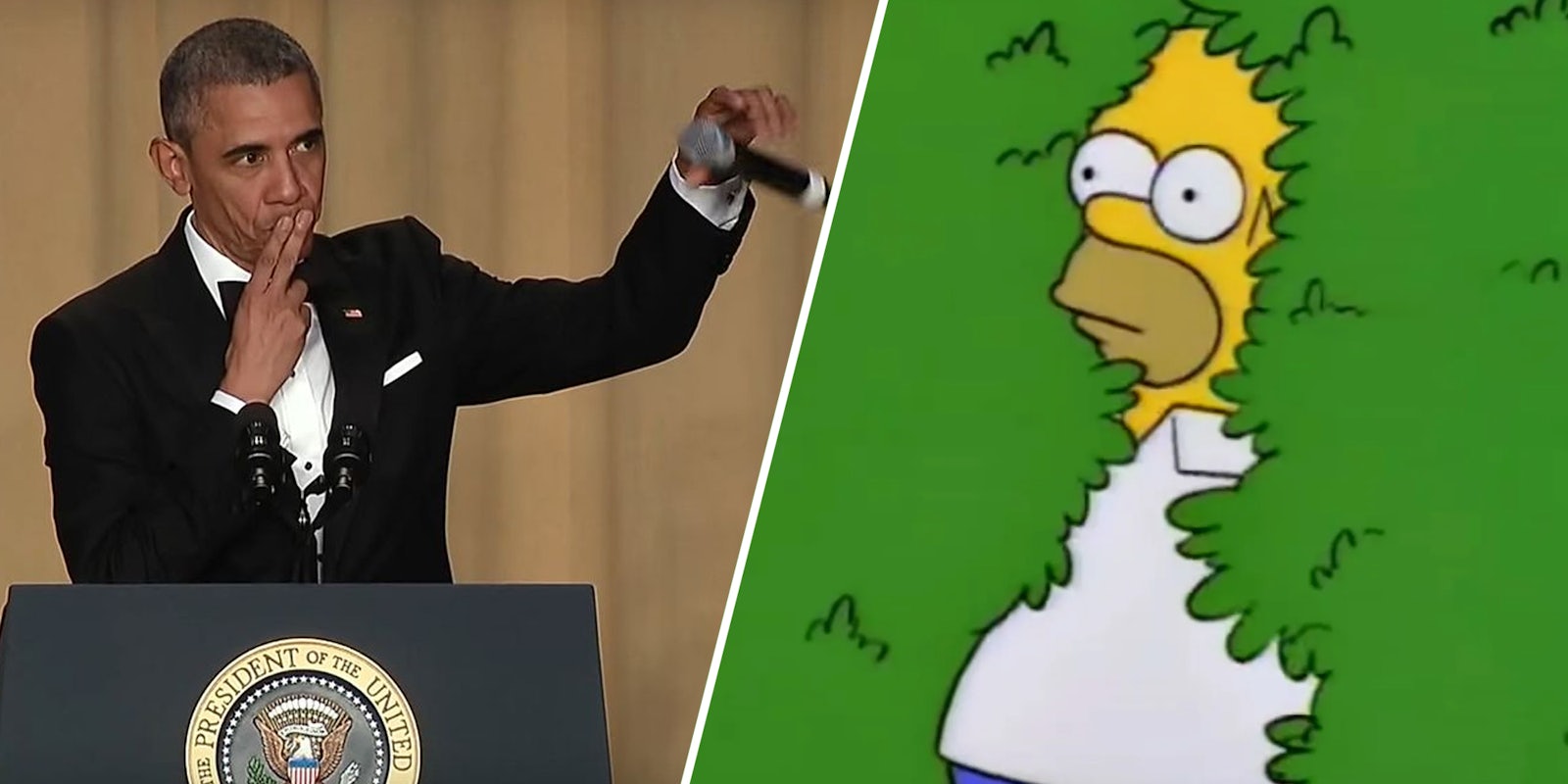
A shortlist of the best ever reaction memes
The reaction meme gif offers a wordless way to express a vast range of emotions, enhancing our digital interactions and making them more relatable and engaging..
Kahron Spearman
Posted on Dec 15, 2023 Updated on Dec 7, 2023, 5:42 pm CST
The reaction memes holds a special place in the continuously evolving digital landscape with their ability to convey thoughts and emotions through a single image. Here’s a shortlist of some of the most iconic reaction GIFs that have defined online expression over the last decade and beyond.
Obama’s mic drop
This iconic moment dates back to President Barack Obama’s final White House Correspondents’ Dinner in 2016, and the resulting GIF is the ultimate symbol of triumph after a successful performance (or online retort).
@aran.dhillon #barackobama #barack #obama #former #president #unitedstatesofamerica #usa #america #unitedstates #politician #politics #micdrop #microphone #fyp #fy ♬ original sound – Aran Dhillon
Blinking white guy
Drew Scanlon’s bewildered reaction from 2013 has become the go-to GIF for expressing surprise or disbelief in online conversations.
@buzzfeed How the ‘Blinking White Guy’ meme was (accidentally) created 👀 #BuzzFeed ♬ original sound – BuzzFeed
The slow clap
The use of this GIF from “Citizen Kane,” starring Orson Welles, oscillates between mocking applause for dubious ideas and genuine acclaim. It just depends on the context.
From parodies in countless films and tv shows and now to memes, CITIZEN KANE's influence continues in popular culture. See the film that started it all on the big screen 9/19 and 9/22. Tickets and showtimes here: https://t.co/TADCe1Erzl #TCMBigScreen pic.twitter.com/Y8jS4bhnjL — TCM (@tcm) September 17, 2021
Michael Jackson eating popcorn
Synonymous with anticipating drama, this GIF from Michael Jackson’s classic “Thriller” music video is perfect for moments when you find yourself a spectator to an unfolding debate or a humorous spectacle.
@mj_gif Don’t mind me I’m just the Michael Jackson gif eating popcorn and reading comments 😜 #michaeljackson #gif #meme #popcorn #comments #fyp ♬ original sound – MJ GIF
Homer slowly backing away
Originally from “The Simpsons,” this versatile GIF captures the essence of awkwardly retreating from delicate situations or internet controversies.
@smilememestation Homer disappears into bushes ♬ original sound – smilememestation
Confused Nick Young
Featuring former NBA player Nick Young , this meme is perfect for showcasing confusion, especially in the context of complex online conversations.
@cocoabutterofficial When Nick Young’s mom called him out on the misadventures of his youth, he never thought his reaction would immortalize him in the halls of internet history # accidentalmeme # storytime # truestory ♬ original sound – Cocoa Butter
Featuring actor Kayode Ewumi as Roll Safe , this GIF from the web series “Hood Documentary” has become a synonymous with clever, but often hilariously flawed, logic and decision-making.
@seasonedbf I Accidentally Became A Meme #rollsafe #meme #fyp ♬ original sound – Seasoned
Leo DiCaprio’s Gatsby
Leonardo DiCaprio’s toast from “The Great Gatsby” is a versatile reaction image that is used to genuinely or sarcastically congratulate or acknowledge someone on the internet.
@dwaynethec0ckjohnson6 #thegreatgatsby #leonardodicaprio #meme #fyp #handsomeman #legend #trendiing #famousactors #moviesceneedits ♬ original sound – Dwaynethec0ckjohnson
Kermit flailing
Kermit the Frog flailing in excitement is an ideal reaction GIF for moments of uncontrollable joy or enthusiasm.
@johnmackstonthe13th #kermitthefrog #meme #discord #plutotvdecades #xyzbca #lasvegas #themuppets #discordmemes #GiveWithAllYourHeart #green #frog #flail ♬ original sound – Yea
Crying James Van Der Beek
This emotional moment from “Dawson’s Creek” has transcended its original context to express intense emotions or as a sarcastic retort to overreactions.
@anxiety_enthusiast James Van Der Beek is so lovely but that cry face tho. 🤣 #fyp #tiktok #90s #2000s #90skids #millennials #throwback #nostalgia #cw #dawsonscreek #edits ♬ original sound – Anxiety Enthusiast
Spiderman pointing meme
Originating from a scene in the 1960s “Spider-Man” cartoon episode, this meme features two or more Spidermen pointing at each other. It has become a staple for situations involving doppelgängers, mistaken identities, or simply calling out someone who’s just like you.
@originofmemes Comment which meme you want to know the origin of #meme #originofmeme #comedy #spiderman #humor ♬ sonido original – OriginOfMemes
A speechless Nathan Fillion
From “Castle,” this GIF of Nathan Fillion being dumbstruck is apt for situations that leave you without words because of shock or surprise.
I couldn't find the original clip of the Nathan Fillion meme from Castle on YouTube, so I decided to digitally purchase the full episode and finally scratch my curiosity. (S2:E9, "Love Me Dead", at the very end) pic.twitter.com/urZzfT6cBc — Jason (@jjstarA113) February 28, 2023
Everything is on fire
From “Community,” this GIF featuring actor and musician Donald Glover as Troy fits into any chaotic or unexpected situation, and is symbolic of the moment things go wildly awry.
Me coming back to FB after a month and a half away: Community Troy Pizza Fire GIF Me coming back to Twitter after a month and a half away: Quarantine beard pictures and D&D memes Never change, Twitter. Never change. pic.twitter.com/ifRjTXDFPm — Andrew Newton (@LlamaNewton) April 12, 2020
Happy Simon Cowell
Capturing a rare moment of joy from Simon Cowell on “The X Factor,” this GIF perfectly expresses unfiltered delight or satisfaction.
@ukiconsonly Who remembers this?! #fyp #fypシ #foryoupage #blowthisupforme #blowthisuptiktok #viraltiktok #susanboyle #susanboyletiktok #simoncowell #amandaholden #piersmorgan #xfactor #xfactorindonesia #xfactorglobal #xfactoruk #audition #bgt #britainsgottalent #britainsgottalentvids ♬ original sound – iconicmoments
Supa Hot Fire’s rap battle victory celebration
The exaggerated reactions of the crowd in this parody rap battle video make for a great reaction to epic comebacks or significant achievements.
@finest_editz_ Who remembers this meme 💀 #foryou #fyp #fypage #finest #rap #edits #fypシ #tiktok ♬ original sound – Finest_editz
‘We Were All Rooting for You!’
Tyra Banks’s intense moment from the often-problematic program “America’s Next Top Model” perfectly expresses disappointment or frustration with others.
@whatdidyoudo83 #BlackTikTok #blacktok #blacktiktokcommunity #f #fyp #foryoupage #foryou #funny #foryourpage #fyps #fyp #viral #backintheday #throwback #americasnexttopmodel #tyrabanks #wewererootingforyou #throwback #realitytv #2000s #tiffanyrichardson #whoyouyellingat #roasting ♬ original sound – Ask first
Shaq’s Gold Bond shimmy
Shaq’s energetic shimmy from a Gold Bond commercial captures excitement and is perfect for moments of joy or approval.
@phineasthecat No explanation needed. 🤷♂️ #phineasthecat #catsoftiktok #cat #orangeisthenewblackandtan #cerebellarhypoplasia #shaq #shaqshimmy ♬ original sound – Phineas
The ‘And I Oop’ reaction
Jasmine Masters, of “RuPaul’s Drag Race” fame, gave us the perfect reaction meme GIF for when we’re confronted with something so startling or absurd that it stops us in our tracks.
@bigmula320 lives rent free #jasminemasters #funny #meme #follow #4u #fyp #humor #TheRealPussinBoots ♬ original sound – bigmula320
Wee-Bey’s reaction
This GIF features Wee-Bey Brice from “The Wire” with a look of pure astonishment. It’s the go-to choice to express shock or disbelief, particularly in situations that turn your expectations on their head.
@chapa94565 #thewire #stringerbell #weebey #idriselba #hassanjohnson #hbo ♬ original sound – Sauce-E- Dough
Trying kombucha for the first time
Also known as “Kombucha Girl,” Brittany Tomlinson’s hilarious, conflicted reaction to tasting kombucha for the first time has become a staple for depicting mixed feelings or indecisiveness.
@brittany_broski Me trying Kombucha for the first time #foryoupage #foryou #fyp #AllBrandNew ♬ original sound – Brittany
Conceited reaction
Rapper Conceited’s expression of skepticism and disapproval during a rap battle has evolved into a universal symbol of doubt and judgment.
@cocoabutterofficial Conceited walks us through the origin of his meme #accidentalmeme #storytime #truestory ♬ original sound – Cocoa Butter
The reaction meme GIF offers a wordless way to express a vast range of emotions , enhancing our digital interactions and making them more relatable and engaging.
Kahron Spearman is the community manager for the Daily Dot and Nautilus magazine. He’s also a journalist, copywriter, and host of “Discovery with Kahron Spearman” on KAZI 88.7.
Featured Local Savings
Your Ultimate Guide to Writing an Exceptional Reaction Paper (2023)

Introduction: What is a Reaction Paper?
Tips on how to write a reaction paper, understand the point of a reaction paper, read the text right after it has been assigned, make a note of your early reactions, select a perspective, define your thesis, organize your sections, write the final version, check your paper for spelling and grammar, reaction paper outline, reaction paper introduction.
- 1. What is a reaction paper?
- 2. How do I start writing a reaction paper?
- 3. What should be included in the introduction of a reaction paper?
- 4. How should I structure the body paragraphs of my reaction paper?
- 5. What is the purpose of the conclusion in a reaction paper?
- 6. Can I get professional assistance with my reaction paper?
- Final Thoughts
Writing reaction papers originated in the early 1900s as a form of response to literature. Initially known as a “response paper,” this writing style gained popularity among scholars and educators as a way to encourage critical thinking and engagement with written works. Over the years, the format evolved, and it became known as a “reaction paper,” emphasizing the writer’s personal reactions and opinions to the material they encountered. Today, writing a reaction paper remains a valuable academic exercise, enabling students to articulate their thoughts, feelings, and insights while analyzing various texts, films , or experiences.
In the realm of art and literature, creators often aspire to evoke profound thoughts and emotions in their audience. While receiving compliments like ‘Amazing’ and ‘Wonderful’ is gratifying, the true mark of a successful piece lies in its ability to be thought-provoking. These thought-provoking works embed themselves in our minds, eliciting reactions and discussions that linger long after the initial encounter. In academic settings, this concept holds true as well. A piece of academic work becomes noteworthy when it evokes reactions from its readers. In this article, we will delve into the essence of a reaction paper and explore how to write one effectively.
At its core, a reaction paper is a written response to a book, article, movie, or any other form of media. It goes beyond a mere summary, delving into the writer’s thoughts, emotions, and analysis of the work’s themes, characters, and other elements. The primary purpose of a reaction paper is to provide a platform for the writer to reflect on and critically evaluate the work, as well as to communicate their insights and opinions to others.
When assigned a reaction paper, it is essential to carefully follow the given instructions, which can typically be found in the course syllabus. Paying attention to the structure, grammar, and citations is crucial to ensure the paper meets the required standards. It is vital to fully grasp the specific requirements to avoid inadvertently writing a reaction paper in the wrong style, such as confusing a Chicago-style reaction paper with an APA reaction paper. In this article, we will offer valuable tips on crafting a flawless reaction paper, accompanied by a sample to serve as a helpful guide.

When it comes to writing a reaction paper, approaching the task with an open mind and actively engaging with the material are essential. Unlike other academic assignments, a response paper allows you to express your personal opinions, making it a relatively easy task. The key is to master the essence and general structure of a reaction paper, enabling you to effectively convey your thoughts and feelings about the subject matter.
To guide you through the process, we have compiled some helpful tips on how to write a reaction paper. However, if your due date is fast approaching , don’t hesitate to seek assistance from our reliable essay writing service online. Our team of expert writers is always ready to lend a helping hand.
Beyond the confines of academia, sharing unstructured opinions about unfamiliar topics is unlikely to leave a positive impression. When you express your personal opinion, it is expected that you have a solid understanding of the subject matter.
Therefore, before delving into your reaction paper, ensure that you fully comprehend its purpose. Whether you are writing a psychology reaction paper or any other type, the key is to deliver valuable and balanced analysis that resonates with readers.
The primary goal of reaction papers is to foster critical thinking skills among students. As a writer, your task is not merely to react to the text but to meticulously analyze its strengths, weaknesses, the author’s intentions, and whether the text accomplishes its objectives.
Understanding the essence of a reaction paper ensures that you remain focused on the assignment’s scope, avoiding any tangents or irrelevant content. It also enables you to concentrate on the most pertinent aspects of the text and present your personal opinion in a clear and logical manner.
While a reaction paper naturally invites your immediate response, it’s crucial to resist the urge to react hastily. Initial thoughts can be ambiguous, biased, and even inaccurate. To form well-founded opinions, you need time for thoughtful consideration.
As soon as you receive the assignment to write a response essay , begin immersing yourself in the material. Dedicate ample time to read, reread, and conduct additional research until you grasp every aspect of the text, from the author’s objectives to their execution of ideas. Take meticulous notes and maintain a balanced perspective.
Aim to develop a strong and thoughtful reaction statement rather than an impulsive and emotionally charged one. Supporting your arguments with gathered information and structuring them coherently will give your paper a more professional and review-like tone, rather than sounding like a casual comment on a movie website.
Speaking of films, below you will find an example of a movie reaction paper. For additional guidance, feel free to explore our article on discursive essay format.
Remember, writing a reaction paper is an opportunity to express your unique perspective and insights, so embrace the process with enthusiasm and a critical eye. Mastering the art of crafting thoughtful and well-structured reaction papers will not only enhance your academic skills but also equip you with valuable tools for expressing your thoughts effectively in various contexts.
As you begin your journey of writing a reaction paper, don’t underestimate the significance of your initial reactions. Jotting down your first thoughts and emotions about the subject matter can be invaluable. These early reactions often represent the rawest and most honest expression of your feelings, providing valuable insight into your perspective.
Noting your early reactions also aids in organizing your ideas and identifying key points to explore further in your academic paper. As you delve deeper into the subject, continue writing down your thoughts to observe how your ideas evolve and progress . This process helps ground your text in your personal experience and ensures a clear and meaningful thesis, meeting the expectations of your instructor for an authentic reflection of your thoughts.
Understanding how a specific piece of art or work evokes emotions and why is crucial to the writing process. By recording personal reactions, you can also recognize any biases or preconceived notions you might have. Acknowledging and examining these biases allows for a better understanding of your perspective and enables you to present a more balanced and nuanced paper. Additionally, noting areas where further research is needed can enhance the depth and credibility of your response.
In writing a reaction paper, selecting a perspective is pivotal as it guides your analysis and provides a structured approach to your response. This ensures that your paper remains focused, well-organized, and offers insightful thoughts.
Before you commence writing, explore different viewpoints on the topic and determine which perspective aligns most closely with your feelings and understanding . Consider the strengths and weaknesses of the selected perspective to gain a comprehensive perspective on the subject matter.
Stepping into the author’s shoes can be enlightening. Reflect on the motives behind the piece, the author’s intentional structure, and their objectives. Such insights will help you analyze the work more clearly and leverage your analytical skills to craft an exceptional reaction paper.
A well-defined thesis statement serves as a roadmap for the rest of your reaction paper, providing clear direction and purpose to your analysis. Crafting a compelling thesis is pivotal as it concisely presents the main idea of your response and helps you stay on track throughout your writing.
Defining a thesis statement might prove challenging, so begin by gathering all your ideas and main points. Identify the notion that resonates most powerfully with you and evaluate its strengths and weaknesses in effectively conveying the central message.
Strive to express your thoughts in a single sentence that blooms into a meaningful response essay, capturing the essence of your analysis and argument.
To avoid confusion and maintain readers’ attention, proper organization of your response paper is essential. A well-structured reaction paper ensures that readers can easily comprehend your argument and follow the flow of your analysis.
Create a coherent outline that provides a clear framework for your response paper, including main sections and sub-sections. Arrange them in a logical sequence, commencing each section with a topic sentence supported by relevant facts, quotes, or examples. Subsequently, present your personal opinion and back it up with a comprehensive analysis. Repeat this approach for each section, culminating in a cohesive and well-structured reaction paper .
After several revisions, your initial draft will evolve into a powerful final version of your reaction essay. Ensure that it encompasses a strong thesis, exhibits a well-structured flow, and radiates polish.
Take the time to thoroughly review the final version, ensuring it aligns with the academic assignment’s requirements and fulfills the expectations of your audience. Revisit your response paper to confirm that your perspective remains clear, your arguments are logical, and they are substantiated with supporting facts. Verify that your paper follows a cohesive structure, presenting your thoughts coherently and persuasively.
During this review, identify and rectify any sections that may veer into mere retelling of the original text, as your goal is to offer a critical analysis infused with your personal opinions . Aim for uniqueness while maintaining an unbiased approach, providing a distinct voice that reflects your genuine reactions and insights.
While the task of writing reaction papers might initially seem tedious, we strive to facilitate the process by offering a valuable how-to-write-a-reaction-paper example, which you can explore in our site.
Grammatical accuracy is paramount, be it for argumentative essays or reaction papers. Your compelling reaction statement and unique perspectives may lose their impact if the sentences lack readability.
Before submitting your reaction paper, meticulously check for grammar and spelling errors. These flaws can detract from the overall quality of your work and undermine your intended message. Moreover, they may hint at a lack of attention to detail, jeopardizing the seriousness and impact of your paper.
By maintaining proper grammar and spelling, you elevate your credibility and ensure that your thoughts and feelings on the subject are effectively conveyed and comprehended. Polished writing, devoid of grammatical mistakes, enhances your reader’s perception of your analytical and communication skills, thereby strengthening the overall impact of your reaction paper.
Incorporate these tips into your writing process to craft a compelling reaction paper that resonates with your audience and showcases your critical thinking and writing prowess. By staying true to your personal reactions and diligently refining your paper, you will produce an engaging and thought-provoking piece that leaves a lasting impression on readers.

As you’ve now become well-versed in the valuable tips and tricks that elevate the art of crafting a compelling response, let’s delve into the fundamental foundation of a stellar reaction paper: the outline. An essential tool in organizing your thoughts and guiding readers through your intricate reflections, the reaction paper outline ensures a seamless and coherent flow that captivates your audience.
The reaction paper outline comprises three key components: the introduction, body paragraphs, and conclusion. Each section carries its unique purpose and holds equal significance in the overall structure of your response essay . Embracing the essence of written assignments, these units stand as pillars to present your specific points with clarity while appropriately crediting direct quotations following formats such as reaction paper APA style or other citation guidelines. So, buckle up for an enlightening journey as we embark on unraveling the intricacies of crafting an impeccable reaction paper outline.
Embarking on the journey of crafting a reaction paper can be both exhilarating and daunting. However, fear not, for we have the perfect guide to master the art of writing an engaging introduction. The opening paragraphs of your reaction paper serve as the gateway to your readers’ hearts and minds, making it essential to leave a lasting impression from the very beginning.
To start your introduction with a bang, focus on providing relevant context for the topic at hand. Enlighten your readers with a concise summary of the background information pertinent to your analysis, setting the stage for a deep exploration of the subject matter. Clearly express the purpose of your paper and articulate the objectives you aim to achieve with your thoughtful reflections. And here’s the key: Conclude your introduction with a powerful thesis statement that encapsulates your unique perspective and the main points that will guide your readers through the captivating journey of your response paper.
Having conquered the introduction, it’s time to dive into the heart of your response paper—the body paragraphs. In this crucial section, your thoughts and feelings take center stage as you explore the major points of the work under scrutiny. Remember, organization is key to maintaining a coherent and impactful presentation.
To master your body paragraphs, divide your ideas into separate sections, each beginning with a topic sentence that reflects the central theme. Provide a brief summary of the specific aspect of the book, article, or media you’re about to delve into, followed by a thoughtful expression of your emotions and explanations behind them. Reinforce your ideas with well-crafted quotes from reliable sources, ensuring proper citation to maintain academic integrity. Aim to connect your reactions to the broader context, showcasing the depth of your understanding.
As you conclude each paragraph, offer a succinct summary of your thoughts and feelings, skillfully tying them back to the paper’s main theme and creating a seamless flow of ideas throughout your reaction paper.
Now, as you reach the culmination of your reaction paper, you’re armed with the power to leave a profound impact on your readers through an impressive conclusion. This is your chance to consolidate your thoughts and emotions, leaving a lasting impression on your audience.
Begin your conclusion by restating your reaction statement, anchoring your readers to the core essence of your response. Reaffirm the key points you eloquently presented in the body sections and provide newfound insights you’ve gained through your analysis. However, it’s crucial to refrain from introducing any new information at this stage. Instead, offer a memorable statement that artfully ties together the main ideas, providing closure and resonating with your readers.
With these invaluable tips, you now possess the tools to craft a remarkable reaction paper, capable of captivating hearts and sparking minds. Whether you’re writing a response to a thought-provoking book, an enlightening article, or even a gripping film, these techniques will elevate your writing prowess and ensure your reaction paper shines bright. So, let your words flow with passion, and leave a lasting impression with your compelling reflections.
FAQs – Writing a Reaction Paper
1. what is a reaction paper.
A reaction paper is a type of academic assignment that requires students to express their personal thoughts and feelings about a specific book, article, movie, or other forms of media. It goes beyond merely summarizing the content and involves critical analysis, reflection, and thoughtful responses to the material.
2. How do I start writing a reaction paper?
To begin writing a reaction paper, approach the task with an open mind and engage actively with the material. Start by understanding the purpose of the reaction paper and identifying its main goal – which is to develop your critical thinking skills . Make notes of your early reactions to the content and take the time to explore and form well-rounded opinions before crafting your response.
3. What should be included in the introduction of a reaction paper?
The introduction of a reaction paper sets the tone for the entire piece. It should provide relevant context, a summary of the background information related to the analysis, and clearly state the purpose of the paper. Additionally, the introduction should present a thesis statement that encapsulates your personal opinion and the main points of your paper.
4. How should I structure the body paragraphs of my reaction paper?
The body paragraphs should be divided into separate sections, each starting with a topic sentence that reflects the main theme of the section. Summarize the specific aspect of the material you want to discuss, share your thoughts and feelings about it, and support your ideas with evidence and proper citations. Connect your reactions to the broader context and conclude each paragraph with a summary of your insights.
5. What is the purpose of the conclusion in a reaction paper?
The conclusion of a reaction paper allows you to summarize your thoughts and feelings, reaffirm your key points from the body paragraphs, and offer new insights you’ve gained from the analysis. It should not include any new information but rather provide closure for the readers and leave a l asting impression based on your raw emotions and thoughtful reflections.
6. Can I get professional assistance with my reaction paper?
Yes, absolutely! GradeSmiths offers top-notch essay writing services, including assistance with reaction papers. Our experienced writers can guide you through the process and help you craft a compelling and high-quality academic paper that will earn you excellent grades. Whether you need help with reaction papers, research papers, or any other type of academic writing, our team is here to support you every step of the way.Top of Form
Final Thoughts
As you embark on the journey of writing a reaction paper, GradeSmiths is here to be your guiding light. Our expert tips and tricks will equip you with the knowledge to produce a compelling and top-notch response essay that will surely impress your professors. So, brace yourself to dive deep into the realm of reflection, clarity, and objectivity, as we unveil the secrets to securing that coveted A+ grade.
With our insightful guidance, you’ll learn to channel your thoughts and feelings into a well-structured paper that captivates readers from start to finish. Supporting your ideas with solid evidence, you’ll craft a persuasive argument that resonates with your audience and showcases your analytical prowess. Plus, our exclusive reaction paper sample will serve as a source of inspiration, helping you master the art of academic writing.
At GradeSmiths, we don’t stop at reaction papers. Our skilled and experienced writers offer a comprehensive range of academic writing services , including nursing essay writing and research paper assistance. With our unwavering commitment to quality, reliability, and academic excellence, you can trust us to deliver outstanding results. So, why settle for less? Experience the GradeSmiths difference and elevate your academic journey today by reaching out for our high-quality essay writing services. Your path to success starts with us!
- RESEARCH PAPER FOR SALE
- RESEARCH PAPER WRITER
- RESEARCH PROPOSAL WRITING SERVICES
- SCHOLARSHIP ESSAY HELP
- SPEECH HELP
- STATISTICS HOMEWORK HELP
- TERM PAPER WRITING HELP
- THESIS EDITING SERVICES
- THESIS PROPOSAL WRITING SERVICE
- TRIGONOMETRY HOMEWORK HELP
- ADMISSION ESSAY WRITING HELP
- BIOLOGY PAPER WRITING SERVICE
- BOOK REPORT WRITING HELP
- BUY BOOK REVIEW
- BUY COURSEWORKS
- BUY DISCUSSION POST
- BUY TERM PAPER
- CAPSTONE PROJECT WRITING SERVICE
- COURSEWORK WRITING SERVICE
- CRITIQUE MY ESSAY
- CUSTOM RESEARCH PAPER
- CUSTOMER CONDUCT
- DISSERTATION EDITING SERVICE
- DISSERTATION WRITERS
- DO MY DISSERTATION FOR ME
- DO MY POWERPOINT PRESENTATION
- EDIT MY PAPER
- English Research Paper Writing Service
- ENGLISH RESEARCH PAPER WRITING SERVICE
- ESSAY WRITING HELP
- ESSAYS FOR SALE
- GRADUATE PAPER WRITING SERVICE
- LAW ASSIGNMENT WRITING HELP
- MARKETING ASSIGNMENT WRITING HELP
- NON-PLAGIARIZED ESSAYS
- NURSING ASSIGNMENT HELP
- PAY FOR COURSEWORK
- PAY FOR ESSAYS
- PAY FOR LITERATURE REVIEW
- PAY FOR PAPERS
- PAY FOR RESEARCH PAPERS
- PERSONAL STATEMENT EDITING SERVICE
- PERSONAL STATEMENT WRITER
- PERSUASIVE ESSAY WRITING HELP
- PERSUASIVE ESSAY WRITING SERVICES
- PHD THESIS WRITING SERVICE
- PROOFREAD MY PAPER
- PSYCHOLOGY ESSAY WRITING SERVICES
- THESIS STATEMENT HELP
- WRITE MY ANNOTATED BIBLIOGRAPHY FOR ME
- WRITE MY CASE STUDY
- WRITE MY DISCUSSION BOARD POST
- WRITE MY LAB REPORT
- Thesis Statement Generator
- Online Summarizer
- Rewording Tool
- Topic Generator
- Essay Title Page Maker
- Conclusion Writer
- Academic Paraphraser
- Essay Writing Help
- Topic Ideas
- Writing Guides
- Useful Information
315 Reaction Paper Topics to Impress Everyone

Expressing your emotions and impressions from reading an article or watching a film seems easier than it is. You can feel overwhelmed after watching Inception by Christopher Nolan, but don’t know what exactly moved you. Was it the music or the main character’s life drama? Writing a reaction paper can be helpful to put together your own thoughts and feelings. Also, discussing things that you like or dislike helps develop your worldview and argumentation skills.
Our team prepared a list of topics for a reaction paper that may inspire you to research something new. What’s more, you can read dozens of excellent sample papers on some of the topics to see how others organized this type of writing piece. Also, we made an ultimate guide for you on how to write a reaction paper. Be sure to check it out!
🔥 10 Best Reaction Paper Topics to Write on
✨ what is a reaction paper.
- ✍ Write a Reaction Paper: Outline and 3 Simple Steps to a Perfect Essay
💡 300 Reaction Paper Topic Ideas
😊 final tips for writing an impressive paper.
- Ray Bradbury’s Dandelion Wine.
- Ralph Ellison’s “The Invisible Man.”
- My take on George Orwell’s “1984.”
- What I think of The Sound and the Fury.
- “Native Son” by Richard Wright.
- What did I like about “The Stranger”?
- “Democracy in America” by Tocqueville.
- My impression of “Lord of the Rings.”
- “Winnie the Pooh” by Alan Milne.
- William Shakespeare’s “King Lear.”
A reaction essay or paper is a writing piece where you’re expressing your personal opinion and feelings after watching a movie, reading a book or an article, or observing an artwork. The distinctive feature of this genre is that you should provide more of your vision rather than related facts and arguments from the critics. A reaction paper might be similar to a review; however, they are different.
Let’s see what their significant dissimilarities are.
- In a review, you refer to the critics of the work you’re describing, while in a reaction paper, you’re displaying personal feelings and emotions.
- A review is a more formal genre, so you shouldn’t use the first-person pronoun. In a reaction paper, you should refer to personal experience.
Writing your opinion on a specific book or article is quite a usual task for students of different levels. You may encounter this type of assignment whether you’re at a middle school or university. While expressing your thoughts seems undemanding, but it becomes complicated when you have to stick to a specific paper structure.
Reaction papers , also known as response papers, summarize what you feel and think about something you’ve read or seen. It can be a book, article, paper, film, etc. Your key objective is to display your impressions, stating what you liked and disliked about the subject of your work. The whole process of working on a reaction paper can consist of three main phases:
- Prewriting phase
- Organizational phase
- Writing phase
In the next block, we will discuss each of them in detail.
✍️ Write a Reaction Paper: Outline and 3 Simple Steps to a Perfect Essay
As we already mentioned, the essay writing process can be split into three stages. Each of them is important, but we will reveal a secret to you – 75% of your success in creating a reaction paper depends on the first two stages: prewriting and organizational phase.
The thing is that if you were attentive to details while watching a movie or reading a book, you’re more likely to understand the topic better. If you manage to create a compelling yet straightforward outline, it will be much easier to complete the whole piece.
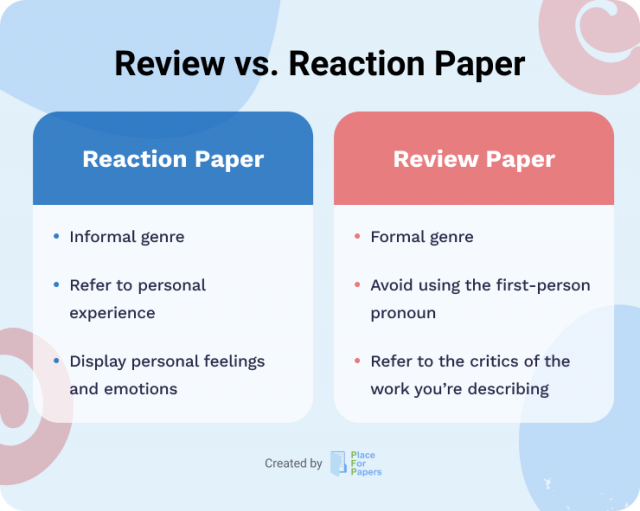
Now, when you know this trick, let’s learn about each phase in detail!
During the prewriting phase , you read or watch the assigned text or motion picture. It’s helpful to ask yourself some questions and write down notes while doing that. These questions will help you organize your primary thought and impressions. They may be like this:
- Do I agree with the author? Why?
- What are the main symbols in this movie/ book/ artwork?
- Is the plot or argumentation logical and clear?
- Are there any inconsistencies?
- Does this piece resemble anything I’ve seen or read before?
- Would I like to watch or reread it?
- Would I recommend it to the others?
When you finish taking the notes, and everything seems clear, you can move to the organizational phase .
The standard sectioning of any academic paper consists of an introduction, main body, and a summary.
Introduction and summary aim at discussing your paper and the results of your investigation in general, while the main body section displays each of your thoughts, arguments, or examples in detail. Recalling the prewriting phase, you can use the answers you’ve given to those questions in different parts of your reaction paper.
Finally, the answer to the questions ‘Would I like to watch or reread it?’ or ‘Would I recommend it to others?’ may become your summary topic sentence.
As you finish organizing your notes and allocating them to different sections of your paper, you can finally move to the writing phase.
If you’ve prepared well, the writing phase won’t be difficult for you. That’s why the previous steps are crucial.
📝 How to Write a Thesis Statement for a Reaction Paper
In the previous section, we talked about a general outline of a reaction paper; now, let’s get to know more about some paper’s key milestones. The first of them is a thesis statement. It’s usually a sentence or two representing the general attitude or point of view regarding the subject. In the case of a reaction paper, it can be the author’s most significant impressions of a movie, book, artwork, or article.
We’ve already mentioned the questions that you can ask yourself during the prewriting phase. The response to the very first question – Do I agree or disagree with the author? – may turn into your thesis statement.
🤔 How to Write an Introduction Paragraph for a Reaction Paper
Still wondering how to start a reaction paper? It’s much easier than it seems! Here are a few steps you should take. First, give your readers the context presenting what you were reading or watching. Then, add a few lines about the author or the history of this piece.
However, if your task is to describe the assigned subject in more detail, write it in a paragraph or two within the introductory part. After this description, write the thesis statement, which should be a compelling thought summarizing the whole idea of your paper. The last sentences of your introduction may state the key aim of your writing piece.
An excellent point to keep in mind:
Your introduction’s last sentence or sentences should form a smooth transition from this part to the main body section. Then, the reader won’t lose interest in the subject and will understand your perspective better.
📖 Reaction Paper: Body and Conclusion
The main body is the section that can consist of multiple paragraphs depending on your assignment and topic. There are no defined rules for this, but we have some recommendations for you.
Previously, we gave you a list of questions for the prewriting phase. So, now you can turn your answers into paragraphs in the main body. Each can be displayed as a separate paragraph using supportive examples from the movie or book you were assigned. You may use the following paragraph structure:
- Topic sentence
- Detail-example-quotation
- Summarizing sentence
As you come to a conclusion or summary, you can use the last questions to write. In a reaction paper conclusion, the author usually restates the thesis statement supporting it with some new ideas mentioned in the main body.
If this seems too complicated, don’t worry; check the sample reaction essay below!
🔖 Reaction Paper: Example
The essay below is an excellent example of a neat reaction paper structure. The author divided their paper into sections, adding subheadings. This helped increase the text’s readability. The first section is introductory; it gives us the context and author’s story.
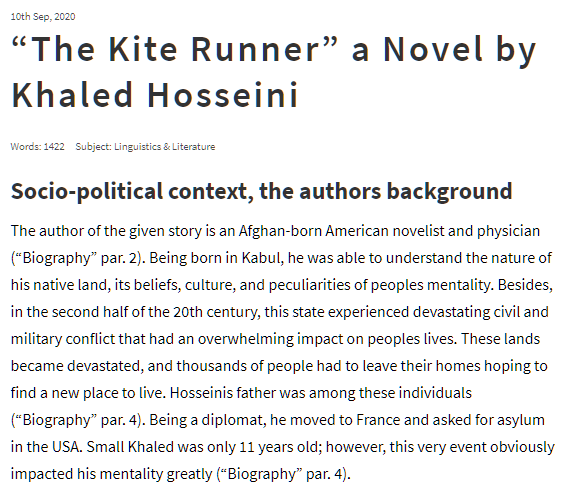
Then, the author provides a brief summary of the book’s plot. If you’re discussing a literary piece that’s not as well-known as The Great Gatsby, for instance, it’s beneficial to present it shortly. No need to provide too many details; you should mention only the most crucial plot milestones.
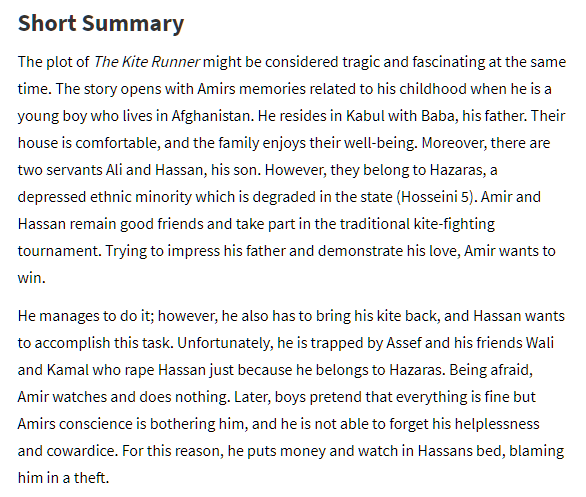
After presenting a brief plot summary, the author gives a list of main characters and those who are also interesting in following through the story. Also, they mention key subjects and issues of the book.
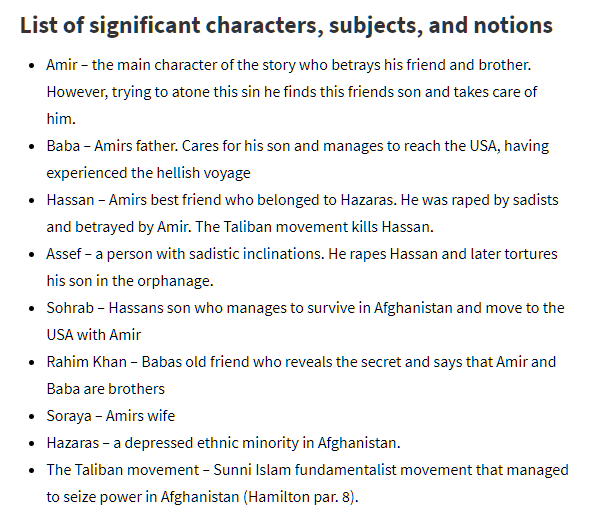
The detailed listing of crucial topics and citations in the book shows the author’s deep understanding of it. This is the level of engagement you should aim at. If you’re writing a reaction paper, using a bulleted list is the most convenient way to present this kind of information.
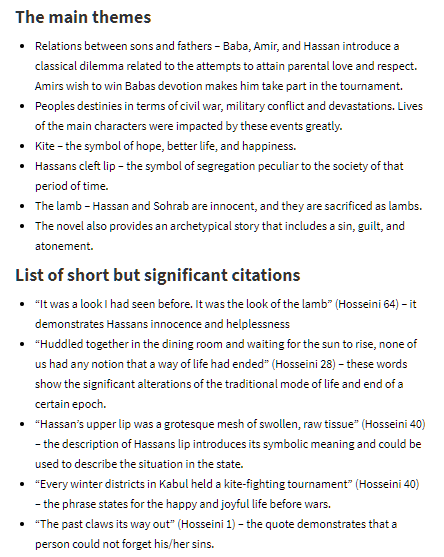
Last but not least, the author describes significant literary elements and their personal impressions. In this part, you can answer the questions ‘Do I agree with the author?’ and ‘Will I recommend this book?’
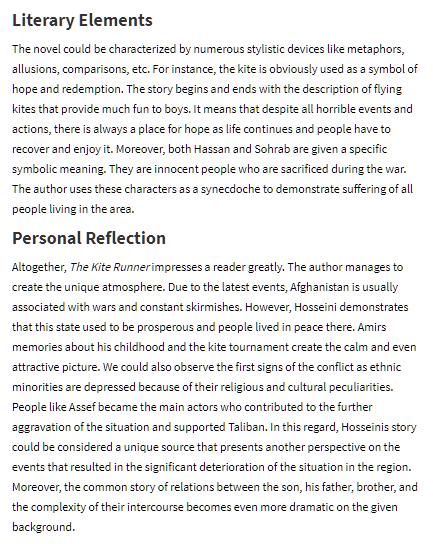
📰 How to Write a Reaction Paper to an Article
You may encounter dozens of articles through your studies at school, college, or university. Some of them may seem compelling and worth reading again, and some may not. Expressing why you agree or disagree with the author is essential for a better understanding of the topic in general. Sometimes students manage to prove that the article’s author had made a mistake in their research or experiment. An open discussion that you can start by responding to somebody’s report will influence your studies’ field in the right way.
Writing a reaction paper to an article is different from those in the previous section, mainly because you need to provide strong arguments to prove your perspective. Here, your emotions become a lower priority. Still, same as for writing about movies or books, you should be wholly engaged in the article you’re reacting to.
Remember that your paper’s structure and its readability are crucial, but don’t also forget about other things that may ruin the best work. One of them is showing disrespect to the article’s author. Even if you disagree with this person, expressing negative rhetoric regarding them is not the best way to prove you’re right.
🎥 How to Write a Reaction Paper to a Movie
Cinematography can be a powerful place to unveil various social, political, or interpersonal issues. Contrary to the books, they offer a ready-made envisioned sequence of events, characters, and much more, so they are easier to comprehend and less time-consuming.
However, some movies may be more profound than they seem, and all the hidden symbols can be less visible to an average spectator. For instance, the award-winning Christopher Nolan works like Inception or Tenet are the ones many watch repeatedly to discover new details and prove their theories.
There’s no doubt that movies sometimes have a therapeutic effect on us, that they may make us change our opinion on a specific issue. That’s why writing a reaction paper to a movie can be highly engaging and fun.
Start by watching a film and taking notes about the moments you like or dislike. Then, write down some phrases or dialogues you find catchy and interesting to dwell on. If there’s anything you haven’t understood about the plot, it would be beneficial to rewatch that moment or whole movie. It’s crucial to comprehend every single detail about the film, so that your evaluation is fair.
📗 How to Write a Reaction Paper to a Book
Reading books is an essential study routine. Still, it’s not enough to simply look through the pages to learn something. Reading should be a mindful process. Even if you’re not assigned a reaction paper on a particular book, it would be highly beneficial to take notes while reading and then give them a fundamental analysis.
Your teacher may assign you writing a reaction paper to a fictional or non-fictional book. Although the preparation process may differ, yo may follow the same structure for both of them. Take these steps to create an excellent reaction paper:
- Write down interesting thoughts from the book while reading. Also, pick some phrases that describe the main characters.
- Answer the questions about the text – whether you agree or disagree with its key thoughts, would you recommend it or not, etc.
- Organize your thoughts and notes, following a bsic outline – introduction, main body, conclusion.
- Expand the outline and finalize the paper.
- Check grammar and punctuation, edit if needed.
If you are bored of overused topics for reaction papers, we have a magic pill for you. Below, you can find an extensive list of exciting and sometimes even challenging topics about books, movies, articles, music, and artworks. There’s plenty of things to choose from – from the Mona Lisa’s smile to the newest album by Lady Gaga. We hope that you will get inspired by these!
📔 Book Reaction Paper Topics
- My thoughts on 1984 by George Orwell
- Animal Farm by George Orwell
- Charlie and the Chocolate Factory: my thoughts on the book
- Jack London: The Call of the Wild
- A Clockwork Orange by Anthony Burgess
- The Adventures of Huckleberry Finn, a book by Mark Twain
- Alexandre Dumas: The Count of Monte Cristo
- Crime and Punishment by Fyodor Dostoyevsky
- Lu Xun: Diary of a Madman and Other Stories
- Anne Frank: The Diary of a Young Girl
- Douglas Adams: The Hitchhiker’s Guide to the Galaxy
- The Hobbit by J. R. R. Tolkien
- Les Misérables, a novel by Victor Hugo
- What impressed me in The Little Prince by Antoine de Saint-Exupéry
- The Mystery of Prince of Denmark by William Shakespeare
- Little Women by Louisa May Alcott
- My impressions of The Lord of the Rings by J.R.R. Tolkien
- My thoughts on The Old Man and the Sea
- One Hundred Years of Solitude, a novel by Gabriel Garcia Marquez
- Pride and Prejudice by Jane Austen
- Kazuo Ishiguro: The Remains of the Day
- The Kite Runner, a novel by Khaled Hosseini
- Slaughterhouse-Five by Kurt Vonnegut
- The Stranger by Albert Camus
- Ulysses by James Joyce
- War and Peace by Leo Tolstoy
- Winnie-the-Pooh by A. A. Milne
- My impressions of The Wonderful Wizard of Oz
- Dracula by Bram Stoker
- The Trojan War: A New History by Barry Strauss
- My impressions on Fahrenheit 451, a book by Ray Bradbury
- Great Expectations a novel by Charles Dickens
- Harry Potter by J.K. Rowling
- The Great Gatsby, a novel by Francis Scott Fitzgerald

- The Iliad by Homer
- Jane Eyre by Charlotte Brontë
- My thoughts on Lolita, a novel by Vladimir Nabokov
- Love in the Time of Cholera by Gabriel Garcia Marquez
- Pippi Longstocking by Astrid Lindgren
- Harlem Ghetto in The Lesson by Tony Bambara
- The Shadow of the Wind written by Carlos Ruiz Zafón
- Milan Kundera: Immortality
- The Unbearable Lightness of Being by Milan Kundera
- Dreams from My Father by Barack Obama
- A Brief History of Time by Stephen Hawking
- A Treatise of Human Nature by David Hume
- Frank Hagan’s textbook Introduction to Criminology
- The Wealth of Nations by Adam Smith
- The Path to Blitzkrieg, a book by Robert Citino
- How Democracies Die, a book by Steven Levitsky and Daniel Ziblatt
- Homo Deus by Yuval Noah Harari
- Games People Play by Eric Berne
- The Death of Expertise, a nonfiction book by Tom Nichols
- Want by Lynn Steger Strong
- Hunger by Roxane Gay
- The Alchemist by Paulo Coelho
- The 7 Habits of Highly Effective People written by Stephen R. Covey
- Gender roles: What’s That Smell in the Kitchen by Piercy
🎞️ Movie Reaction Paper Topics
- Thoughts on The Birth of a Nation movie
- Mad Max: Fury Road by George Miller
- The Godfather by Francis Ford Coppola
- 8 ½ by Federico Fellini
- Parasite by Bong Joon Ho
- The Shining by Stanley Kubrick
- A Clockwork Orange by Stanley Kubrick
- 12 Angry Men drama movie
- My thoughts on Blade Runner and Blade Runner 2049
- Reservoir Dogs by Quentin Tarantino
- Tenet by Christopher Nolan
- The movie The Boy in The Striped Pajamas by Mark Herman
- Call Me By Your Name by Luca Guadagnino
- American Psycho by Mary Harron
- The film Memento by Christopher Nolan
- The Great Dictator by Charlie Chaplin
- Pulp Fiction by Quentin Tarantino
- Star Wars by George Lucas
- La Dolce Vita movie by Federico Fellini
- The Matrix by the Wachowskis
- The film Anatomy of Hate by Mike Ramsdell
- Back to the Future by Robert Zemeckis
- Lady Bird by Greta Gerwig
- The Social Network by David Fincher
- Baby Driver by Edgar Wright
- The Foreigner by Martin Campbell
- Reacting to Interstellar
- My opinion on the movies about James Bond
- Night of the Living Dead, a movie by George Romero
- Scary Movie by Keenen Ivory Wayans
- Wanda Vision – a cool vintage story
- Impressions of the Chernobyl mini series
- 21 Jump Street by Christopher Miller and Phil Lord
- The Grand Budapest Hotel by Wes Anderson
- The Square by Ruben Östlund
- My impressions of the last season of Game of Thrones
- The Pianist movie by Roman Polanski
- Legend by Brian Helgeland
- Knives Out by Rian Johnson
- Sleepers, a movie by Barry Levinson
- My thoughts on Minding the Gap by Bing Liu
- Jiro Dreams of Sushi, a documentary by David Gelb
- The Invisible War by Kirby Dick
- Journey Through French Cinema by Bertrand Tavernier
- Sholem Aleichem: Laughing in the Darkness by Joseph Dorman
- Three Billboards Outside Ebbing, Missouri
- The movie Story of a Puppet
- The Irishman by Martin Scorsese
- Marriage Story by Noah Baumbach
- Thoughts on the Harry Potter movies
- The Constant Gardener, a movie by Fernando Meirelles
- My thoughts on Jim Jarmusch’s movies
- My impressions of The Wolf of Wall Street
- Lobster by Yorgos Lanthimos
- The Hunger Games: Mockingjay – Part II
- The Gentlemen by Guy Ritchie
- Magic Mike by Steven Soderbergh
- A Beautiful Day in the Neighborhood
- The Shawshank Redemption motion picture by Darabont
- Booksmart by Olivia Wilde
- The Salt of the Earth – an amazing motion picture
- My impressions of Soul by Pixar
- Thought on the movies by Edgar Wright
- Personal impressions of Catch Me If You Can
🎭 Artwork Reaction Paper Topics
Like movies and literature, other artworks like paintings or sculptures can impress or even change our lives. It’s hard to overrate Mona Lisa or Michelangelo’s David’s impact on society through the centuries. However, the perception of fine arts may be more complicated than of books or films. Why so?
Some artists, for instance, Pablo Picasso, believed that trying to understand a painting or a sculpture is a losing game. This famous artist once said:

While in books or films we may catch the author’s explanation of his vision or just an implication, fine arts give us more freedom to discover what our mind and emotions lead us to. And it contradicts what the author or art critics declare quite most of the time.
We gathered legendary and less well-known artworks in the list below. It’s your chance to look at them once again and get inspiration for your paper!
- Mona Lisa by Leonardo Da Vinci
- My thoughts on The Starry Night by Vincent Van Gogh
- Girl with a Pearl Earring by Johannes Vermeer
- The Birth of Venus by Sandro Botticelli
- The Kiss by Gustav Klimt
- The Arnolfini Portrait by Jan van Eyck
- Personal impressions of the Hieronymus Bosch’s paintings
- A Sunday Afternoon on the Island of La Grande Jatte by Georges Seurat
- Les Demoiselles d’Avignon by Pablo Picasso
- Marc Chagall’s paintings
- Le Déjeuner sur l’herbe by Édouard Manet
- Collective Invention by Rene Magritte
- Golconda by Rene Magritte
- The Persistence of Memory by Salvador Dali
- Salvador Dali: The Temptation of Saint Anthony
- Galatea of the Spheres by Salvador Dali
- My thoughts on Composition with Red, Blue, and Yellow by Piet Mondrian
- The hidden treasures of Las Meninas by Diego Rodríguez de Silva y Velázquez
- My impression of Guernica by Pablo Picasso
- Kathe Kollwitz’s Death and the Mother painting
- Liberty Leading the People by Eugène Delacroix
- Wanderer above the Sea of Fog by Caspar David Friedrich
- Nighthawks by Edward Hopper
- Campbell’s Soup Cans by Andy Warhol
- My impressions of Maman by Louise Bourgeois
- My thoughts on Damien Hirst’s artworks
- Girl with Balloon by Banksy
- Olympia, the paiting by Edouard Manet
- Flower Ball by Takashi Murakami
- Balloon Dogs by Jeff Koons
- Self Portrait by Frida Kahlo
- Remembering an installation by Ai Weiwei
- Orange, Red, Yellow by Mark Rothko
- Reaction to the Number 5, 1948 painting by Jackson Pollock
- Impressions of Pietà by Michelangelo
- David by Michelangelo
- Dama Velata by Antonio Corradini
- Apollo and Daphne by Gian Lorenzo Bernini
- Leonardo Da Vinci painting – The Last Supper
- Winged Victory of Samothrace
- The Thinker by Auguste Rodin
- Psyche Revived by Cupid’s Kiss by Antonio Canova
- Le Génie du Mal by Guillaume Geefs
- The Endless Column, a sculpture by Constantin Brâncuși
- Edward Weston: Pepper No. 30
- My thoughts on The Venus of Willendorf statue
- Dog by Alberto Giacometti
- Reclining Figure by Henry Moore
- In and Out of Love by Damien Hirst
- Impressions of Fountain by Marcel Duchamp
- My thoughts on Yayoi Kusama’s installation art
- Gaia Mother Tree by Ernesto Neto
- Forest of Numbers by Emmanuelle Moureaux
- The Rubicon by Jason Decaires Taylor
- A mural by Dmitri Vrubel on the ruins of the Berlin Wall
- Make Art Not War by Shepard Fairey
- Nobody Likes Me by Iheart
- Hollow by Katie Paterson and Zeller & Moye
- Mirage house by Doug Aitken
- US-Mexico border wall seesaws by Rael San Fratello
🎵 Music Reaction Paper Topics
Music, same as fine arts, is more abstract and subjective than literature and cinematography. A charming melody for one can sound intimidating for the other. Music is a powerful tool that can enforce visual arts. For instance, in films, it combines with the moving picture to impact viewers. Music can be played in museums to create a specific atmosphere and let visitors immerse themselves in it. Different songs and melodies can influence our mood, and it’s interesting to observe how it impacts us.
Writing a reaction paper about a song or melody you like or about the one you hear for the first time is a curious experience. You may get numerous insights and understand how music relates to your personality. Check the topics for the music reaction paper we prepared for you below!
- Music as a part of life.
- Peer Gynt Suite No. 1 Op. 46: Morning Mood by Edvard Grieg
- Symphony No. 5 in C minor by Ludwig van Beethoven
- Impressions of The Four Seasons by Antonio Vivaldi
- Thrilling classics: The Valkyrie: Ride of the Valkyries by Richard Wagner
- Nocturne No. 2 by Frédéric Chopin
- Carmina Burana: O Fortuna by Carl Orff
- Swan Lake Suite, Op. 20: Scene by Pyotr Ilyich Tchaikovsky
- Erik Satie – Gymnopédie No. 1
- Requiem, K. 626: Lacrimosa Dies Illa by Wolfgang Amadeus Mozart
- Suite bergamasque, L 75: Clair de Lune by Claude Debussy
- Hungarian Dance by Johannes Brahms
- Carmen Suite No. 2: Habanera by Georges Bizet
- Mainly Mozart concert
- Egmont, Op. 84: Overture by Ludwig van Beethoven
- Für Elise by Ludwig van Beethoven
- Ella Fitzgerald – an iconic jazz singer
- Legendary songs by Frank Sinatra
- La Vie en Rose by Edith Piaf
- Masterworks of 20th-century Music
- My impressions of the album Bridge Over Troubled Water by Simon and Garfunkel
- Electric Ladyland an album by Jimi Hendrix
- My thoughts on Bob Dylan’s music
- Impressions of A Night at the Opera by Queen
- Louis Armstrong’s Interpretation of “Black and Blue”
- Bob Marley’s Running Away Song
- Dwelling on the Joy Division’s album Closer
- Surrealistic pillow a music album by Jefferson Airplane
- Off the Wall by Michael Jackson
- Rumours by Fleetwood Mac
- Impressions of David Bowie’s music
- The Wall by Pink Floyd – one of the greatest albums of all times
- Nevermind by Nirvana
- My thoughts on the Revolver music album by The Beatles
- Modern classics: Yann Tiersen and Ludovico Einaudi
- Justified an album by Justin Timberlake
- Nick Cave and the Bad Seeds: band story and music
- Lady Gaga – The Fame
- Late Registration by Kanye West
- American Hip Hop Music
- My impressions of Drake’s music
- Lana Del Rey – Born to Die
- Turn on the Bright Lights by Interpol
- Impressions of the music by Daft Punk
- Modern romantics: the album Whatever People Say I Am, That’s What I’m Not by Arctic Monkeys
- Legendary album Back to Black by Amy Winehouse
- In Rainbows by Radiohead
- Kid A by Radiohead
- Portishead: Third
- Elephant an album by The White Stripes
- Innerspeaker by Tame Impala
- Toxicity by System Of A Down
- Plastic Beach by Gorillaz
- Music by Muse: personal impressions
- An Awesome Wave by alt-J
- In Tongues by Joji
- Hooverphonic: modern vintage
- Thoughts of contemporary disco-pop music
- Impressions of K-pop
- Asian pop rock
- Music by XXXTentacion
- Trap music and gangsta rap today

🗞️ Article Reaction Paper Topics
- Learning at Work , article by Stephen Billet
- Infusing critical thinking into an employability skills program: the effectiveness of an immersion approach article by Sophie Kennedy
- Writing Assessment and Cognition by Paul Deane
- Farai Mamina Mutimusakwa: Relationship Between Job Analysis, Job Description & Job Specification
- Beauty Standards: “The Body Myth” by Rebecca Johnson
- Model of Employee Performance: Ability, Motivation, and Opportunity in Manufacturing Company by Johan Oscar
- A Tale of Two Pandemics: Evolutionary psychology, Urbanism, and the Biology of Disease Spread Deepen Sociopolitical Divides in the U.S. by Lawrence A. Kuznar
- Fifty Years of Ecology by A. Macfadyen & P. J. Newbould
- Reply to: Observed Impacts of the COVID-19 Pandemic on Global Trade by Daoping Wang, Klaus Hubacek & Dabo Guan
- Robots, Labor Markets, and Universal Basic Income by Antonio Cabrales, Penélope Hernández & Angel Sánchez
- Sumaiya’s How to Lose a Job in Ten Days article
- The Importance of Diversity on Boards of Directors’ Effectiveness and Its Impact on Innovativeness in the Bioeconomy by Marko Hakovirta, Navodya Denuwara & Jorma Eloranta
- Sustainability and Bank Risk by Bert Scholtens & Sophie van’t Klooster
- Integrity and Justice: What Is Required of Free Market Participants? by David Bauman
- Gérard Hirigoyen & Amélie Villeger: Women and Power: a Theoretical Approach Using the Example of Copreneurial Businesses
- Who’s in Charge? Corporations as Institutions of Global Governance by Christopher May
- Prashant Goswami, Shiv Narayan Nishad & Dhanya Selvaratnam: A Deterministic Model of a Research Organization’s Evolution and Dynamics of Performance
- Apathy, Excitement, and Resistance: Teaching Feminism in Business and Management Schools by Katherine Sang & Steven Glasgow
- Marta Kuc-Czarnecka & Magdalena Olczyk: How Ethics Combine with Big Data: a Bibliometric Analysis
- Elizabeth Tait, Konstantina Martzoukou & Peter Reid: Libraries for the Future: the Role of IT Utilities in the Transformation of Academic Libraries
- A Dynamic Analysis of Financing Conditions for Renewable Energy Technologies by Florian Egli, Bjarne Steffen & Tobias S. Schmidt
- Patrik Lindenfors, Matthew Wilson & Staffan I. Lindberg: The Matthew Effect in Political Science: Head Start and Key Reforms Important for Democratization
- Societies within Peace Systems Avoid War and Build Positive Intergroup Relationships by Douglas P. Fry, Geneviève Souillac, and others
- A Phylogenetic Analysis of Revolution and Afterlife Beliefs by Kiran Basava, Hanzhi Zhang & Ruth Mace
- Religion: A Crusade for Compassion by Douglas Todd
- Damian J. Ruck, Luke J. Matthews, and others: The Cultural Foundations of Modern Democracies
- Heritage and Interculturality in EU Science Diplomacy by Casper Andersen, Cristina Clopot & Jan Ifversen
- David Kaniewski & Nick Marriner: Conflicts and the Spread of Plagues in Pre-Industrial Europe
- Hannah Grenham: The Mechanical Monster and Discourses of Fear and Fascination in the Early History of the Computer
- The Evolving Response to Antibiotic Resistance (1945–2018) by Scott H. Podolsky
- Dennis Doyle: Slums, Race and Mental Health in New York (1938–1965)
- Jimmy Yu: Blood Writing as Extraordinary Artifact and Agent for Socioreligious Change
- Exploring Linguistic Features, Ideologies, and Critical Thinking in Chinese News Comments by Yang Gao & Gang Zeng
- Hang Lee: Voters’ Involvement, Attitude, and Confidence in the Era of New Media
- The Ironies of Autonomy by Maya Indira Ganesh
- Fake News Game Confers Psychological Resistance Against Online Misinformation by Jon Roozenbeek & Sander van der Linden
- How Character Limit Affects Language Usage in Tweets by Arnout B. Boot, Erik Tjong Kim Sang, Katinka Dijkstra & Rolf A. Zwaan
- In Digital We Trust: Bitcoin Discourse, Digital Currencies, and Decentralized Network Fetishism by Jon Baldwin
- Hopes and Fears for Intelligent Machines in Fiction and Reality by Stephen Cave & Kanta Dihal
- Cognitive Attraction and Online Misinformation by Alberto Acerbi
- Torben Grodal: How Film Genres Are a Product of Biology, Evolution, and Culture — an Embodied Approach
- Underestimating Digital Media Harm by Jean M. Twenge, Jonathan Haidt, Thomas E. Joiner & W. Keith Campbell
- Guns Don’t Kill People…: Good Guys and the Legitimization of Gun Violence by Angela Stroud
- Affective Polarization, Local Contexts and Public Opinion in America by James N. Druckman, Samara Klar, Yanna Krupnikov, and others
- Why Does Intellectuality Weaken Faith and Sometimes Foster It? by Mustafa Emre Çağlar
- Do Guide Dogs Have Culture? The Case of Indirect Social Learning by Dominique Guillo & Nicolas Claidière
- Elizabeth Frankenberg, Cecep Sumantri & Duncan Thomas: Effects of a Natural Disaster on Mortality Risks Over the Longer Term
- Mathew E. Hauer: Migration Induced by Sea-level Rise Could Reshape the US Population Landscape
- Abhishek Samantray & Paolo Pin: Credibility of Climate Change Denial in Social Media
- Thinking in Rural Gap: Mobility and Social Inequalities by Luis Camarero & Jesús Oliva
- Rebekka Kesberg & Stefan Pfattheicher: Democracy Matters: a Psychological Perspective on the Beneficial Impact of Democratic Punishment Systems in Social Dilemmas
- One Giant Leap for Capitalistkind: Private Enterprise in Outer Space by Victor L. Shammas & Tomas B. Holen
- Megan Rogers & Mary Ellen Konieczny: Does Religion Always Help the Poor? Variations in Religion and Social Class in the West and Societies in the Global South
- Discourses of Technology, Ageing, and Participation by Aysha Fleming, Claire Mason & Gillian Paxton
- Socially Mediated Populism: the Communicative Strategies of Political Leaders on Facebook by Gianpietro Mazzoleni & Roberta Bracciale
- Emiliana De Blasio & Michele Sorice: Populism Between Direct Democracy and the Technological Myth
- Ruta Clair, Maya Gordon, Matthew Kroon & Carolyn Reilly: The Effects of Social Isolation on Well-being and Life Satisfaction During Pandemic
- Multi-task Reinforcement Learning in Humans by Momchil S. Tomov, Eric Schulz & Samuel J. Gershman
- Cognitive Biases and Mindfulness by Philip Z. Maymin & Ellen J. Langer
- Sugar Tax: Caries is the Disease by J. A. Beeley
- Steffen Huck, Johannes Leutgeb & Ryan Oprea: Payoff Information Hampers the Evolution of Cooperation
Choosing an engaging topic is crucial, but it’s not enough for your paper to impress the audience. An excellent writing piece is equally engaging , readable , and compelling . To get high points in these criteria, avoid these common mistakes:
- Providing too much criticism and not giving arguments to support it;
- Presenting biased judgments;
- Admitting your incompetence;
- Writing too many words in the summary;
- Not explaining your attitude;
- Utilizing overused vocabulary.
This list can go on, but let’s stop by here and see how you can avoid these mistakes in practice!
- Each time you provide a critical thought, support it with a fact, or someone else’s quote.
- Check that your introduction has a similar amount of words as your summary and, most importantly, that they are smaller than the main body section.
- Provide proper argumentation why you like/dislike something or agree/disagree with the author.
- Search for synonyms to the overused words, such as good, bad, necessary, difficult, different, useful, etc.
- Remember to write shorter and clearer sentences with easy-to-comprehend syntax.
Last thought to bear in mind:
Your reaction paper is a space to express and argue your opinion on a specific issue freely, but you should remember to respect the author regardless of your attitude.
We hope that this article inspires you to create an excellent essay or research paper. Stay tuned!
🔗 References
- Writing a Response or Reaction Paper – Hunter College
- Reviews and Reaction Papers – University of Maryland
- The 10 Best Nonfiction Books in 2020 – Time
- Reaction Paper – Sunny Empire State College
- Research Guide – University of Michigan Library
- 9 Tips for Writing a Film Review – New York Film Academy
- The 100 Best Nonfiction Books of All Time – The Guardian
- Expressing Opinion & Attitude – University of Wollongong Australia
- Writing About Film: Terminology and Starting Prompts – Purdue OWL
- Strategies for Essay Writing – Harvard University
- The Death of the Five Paragraph Essay – Yale University
- A reading list on issues of race – Harvard Gazette
- The 20 Most Rewatchable TV Shows – The Los Angeles Film School
- Top 6 Albums of the Year (So Far) – The Los Angeles Film School
- Tips And Strategies for the Effective Essay Writing – Dr. Michael W. Kirst
- Shiller Paper Cited as One of The Century’s Top Economic Articles – Yale University
- How to Critique a Journal Article – Carnegie Mellon University
- Mr. Showbiz’s 100 Best Movies of All Time – CMU
- Avoid Common Pitfalls – OWL Purdue
- Writing about Music – UNC Writing Center
- Writing a Paper on Fiction in 9 Steps – UNC Writing Center
Goodwall Blog

Join Now! Download the Goodwall App
You'll be able to register on web soon! For now, download our app on your mobile device for the best experience!
How to Write a Reaction Paper: 10 Essential Tips
If you are tasked with writing your first response paper, this guide can help. here are tips on how to write a reaction paper for students..
High school or college students are often asked to write dozens of essays and papers while studying. This can be overwhelming and lead to losing confidence in one’s academic skills if someone starts to struggle in this area. Are you having such trouble, and would you like help to get off the ground?
Below, we discuss some of the finer details of how to write a reaction paper, one of the many types of paper you might need to create. With these reaction paper tips, you should be able to get rolling and finish them well in time for a hand-in. They might not make it a breeze, but they should take the edge off to make it a valuable and educational task for you in the long run.

Need Support As You Navigate the College Scene?
Sign up to Goodwall!
- Connect with like-minded students from 150+ countries
- Search through more than $1.5 million in scholarships
- Ask your university questions and get support
Download the app now to get started for FREE!
Consume the Original Media with Care
When your educator is considering topics for papers, they will often have a very good reason for choosing the media you will analyze. This may be its relevance to the current world, its historical context, a long tradition of experiencing it, or many other reasons. No matter what it may be, pay attention when taking it in.
If it is a book, read it in your own time and during school. Make notes as you go and ensure you understand what it is communicating explicitly and implicitly.
If it is a film, do not only enjoy the story but engage with its themes. Also, consider why the creators chose to film it as it is and consider the media from the point of view of other characters in the piece. Look into who created it, consider their reasons for creating it over and above money, and consider why they thought this film was good.
Analyze the Media for the Core Themes
As you take in the media, consider if the person or people who created it had any message they were trying to convey. This may be a moral, an attempt to make people see things from a new perspective or to teach people about a truth they believe in.
Even if this is not a fictional piece or a historical document such as a constitution, consider who the implied heroes are. Why did the writer use the language choices they did, and how did that affect the media?
What is the villain in the piece’s motivation? You may find yourself sympathizing with their point of view, though consider their means and methods to be the thing that makes them a villain. Or, they may not be villainous but only an antagonist to the heroic figures.
Even in something like the United States Declaration of Independence, for example, there is a lot to consider. You can think about the different reasons it had the language it did, the points it makes, and why these points are essential to the writers . You can also think about what the writers were trying to create at the time and why they thought this was the best way of going about it.
Related Read : What Is a Capstone Project? All You Need to Know on College Capstones
Work Out How You Feel
When writing a thesis for papers, you might often need to leave out a lot of your feelings. Still, they are important to understand so you can know what the media drives you to think and believe.
Consider the possibility that your view of the subject is wrong; also consider that you are the one who is correct and the media is who is wrong. Think about how both make you feel about the topic they portray.
You can use these to guide the discussion you wish to have in two ways. First of all, you can use them to help you write about areas that interest you more. Second, you can also be aware of your biases and try to avoid writing emotionally, as that could affect how others read your paper.
Start Planning
The next thing you should do is begin creating a reaction paper outline. Think about the different points you want to make, and write them all down. Align them with any evidence you have so you can spread these concepts through the paper, along with things that might back you up.
Also, in short, ensure you are making a point. The last thing you want is to get several paragraphs in and then realize you are not analyzing it or coming to any sort of conclusion. Think about what you want to say in broad and specific terms.
Related Read : What Should I Major In? The Complete Guide on How to Choose a Major
Create the Headers
Once you have your outline, start planning each header out. Your reaction paper format should include an introduction and conclusion header at the start and end. It should also delve into several different points throughout that support or talk against them.
Ensure the headers constitute a single train of thought, telling a “story” by how it starts, continues, then ends through the whole piece.
Begin With an Introduction
Your introduction should start with a hook to get people interested in the piece from the get-go. This could be a statistic, a quote, or even a very forward statement that draws heads.
From there, talk about what you intend to write about and what you want to do. This might be stating an intent to perform research or to discuss how someone or something was correct or incorrect. It could even discuss the nature of a theme in general and how the media portrayed it.
Write the Header Bodies
You can now go through each header, stating your thoughts about each section. Try not to repeat yourself through these areas, as it could harm the readability of the piece; it could confuse readers and break the flow of the paper.
This section is the meat of what you are writing. You want each header body to state and back up a single point you wish to make. Then, by the conclusion, what you are trying to say should already be obvious.
When you write these, also think about the evidence or quotes you have that you can use to back up your points. You can put them here or in an appropriate appendix at the end of your paper, depending on the demands of your education system.
Related Read : 15 Excellent SAT Tips to Help You Do Well on the Big Test
Conclude Thoughtfully
Your conclusion should reiterate your introduction’s core premise. It can then summarize your main arguments. As the reader goes through the conclusion, they should not doubt what their thoughts and beliefs are when it comes to the media.
The conclusion is also a great place to tie all your points together. Sometimes some headers might go off in different directions, so you can use this space to bring everything into one coherent point.
The one thing you should avoid doing here is bringing up any new thoughts or points. The conclusion should round out everything and not leave any loose ends. When you finish it off, end with a strong statement that leaves an impression on the person reading it, such as a quote, a question, or a call to action.
Edit the Work With Care
Once you have completed one reaction paper draft, review it and look for errors. Read the piece aloud and try to find areas where your writing does not live up to a good standard or where you repeat points. You can also often hear repeated words you can change to make the paper easier to read as a whole.
You might find some sections unnecessary or that you need to add to them to help make sense. If you do, try to ensure you keep the flow of the piece and it does not start to ramble.
If you are writing this paper on a computer instead of hand-writing it , now is also the perfect time to use a spell-checker and grammar checker.
Be Clear and Concise
One of the most important rules when it comes to how to write a response paper is to ensure you do not write too much for each point. Do not use one hundred words when ten will do to say the same thing.
Be very clear in what you are saying too. Be aware that adverbs can start to water down any point you make if you overuse them. Although, you should also understand their power to allow you to make a paper more unique and precise.
Related Read : 13 Best Productivity Tips: Advice for Boosting Quality & Output
More on How to Write a Reaction Paper
You can often apply many of these response paper tips to other things people may ask you to write in your academic career. Still, there are many more things to learn before you are a master of the written word. Luckily for you, we have many articles on how to continue to improve your work.
So, check out our blog for all the latest tips on how to write a reaction paper and impress your family and teachers today.
Download our app today!
Cancel reply.
Your email address will not be published. Required fields are marked *
Write a Response...
Email Address *
Save my name, email, and website in this browser for the next time I comment.
Your Privacy

reaction Meme Templates
Mr. mcmahon reaction.

Vince McMahon Reaction w/Glowing Eyes

Live reaction

Surprised Joey

Bernie Sanders reaction (nuked)

Dean Norris's reaction

Reaction Guys

Live X Reaction

Dean Norris reaction

Robert Pattinson My Honest Reaction

Joey Friends
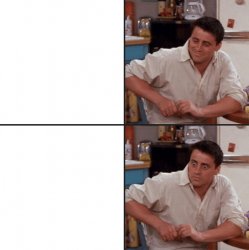
Vince McMahon Reaction

Conceited Reaction

Vince McMahon reaction
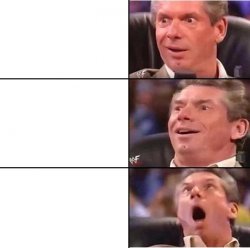
Black Guy Seizure

Bernie Sander Reaction (change)

reaction guys

crying computer reaction

Mario looks at computer

Keeps getting better

Soyjak Reaction

Vince Mcmahon

Survivor Reaction

Master oogway's honest reaction

LIVE REACTION

Reaction Guys (reversed)

Sad cartoon

kevin hart reaction

Hank Angry-Happy

before and after reaction

GOOD and BAD meme

Annoyed Angel Reaction

Soyboy reaction mad cry

My Honest Reaction

Joe Rogan ufc 248 reaction

Trump Interview Reaction


How to Write a Reaction Paper-With Examples
Introduction.
Reaction papers do not require the same kind of research as regular essays or other writing assignments. Reaction papers require that writers explain their opinion about something based on what they have experienced, thought about, or witnessed. Information about the topic that the writer has learned elsewhere is fine, but it should not be presented as a fact.
The process of writing a reaction ideally has two parts:
Part 1: Drafting a summary
Part 2: Writing the actual paper
First Part: Drafting a Summary
What makes a reaction paper different from other papers is that it must include a summary of the material that the writer has read, watched, or experienced. The best way to begin writing a reaction paper is with a quick draft of a summary
Here are some questions the summary answers:
- Who is the author/do they have any authority?
- What is the date of publication?
When writing the summary, ensure to keep in mind the following
- Use direct quotations only when they provide crucial information.
- Generalize the ideas in the text without going too much into details.
- Keep the personal reaction for the next part.
- Provide information that is factual and objective
Just follow the simple steps below!
Second Part: Writing the Reaction Paper
Prewriting for your reaction paper.
Anyone can have an opinion about something, but not everyone can write a good reaction paper. Before the writer begins writing, they should think about the topic and determine what their specific thoughts are on it. This will allow them to decide what direction they want to go with their introduction and thesis statement.
During the prewriting process, understand the following:
• Note down your initial reactions
Your first impressions of the text are often the most accurate. Remember that these first impressions may be based on your mood, so monitor yourself for thoughts about the text that might not be fair or objective. Also, recognize when it is appropriate to write down reactions while reading the text and not when until you have read the entire thing.
You are more likely to write a clear, concise, and exciting reaction paper by noting down these reactions.
• Reaction paper needs your personal opinion
The more the personal opinion is included, the better.
o It makes your response unique and interesting to read.
o Without these opinions, a response is just another review . Look at reviews of movies; they are all about what happened but never about why you think it is good or bad.
• Determine your angle
Reactions are all about different angles through which people understand things.
Determining your angle in advance will help you structure your paper in a compelling way. It is surprising how little thought is given to the angle. Your angle will give the reaction paper a uniqueness that a review will not have.
• Determine your tone
o Guiding questions like the following may help you decide on the tone of your reaction paper.
– What is my opinion about this?
– How does this relate to what I’ve read, watched, or experienced in life?
– Do I agree with “x”? Why or why not?
– What evidence do I have to support my perspective?
– What is the significance of this topic to me? Why should anyone care about it?
• Understand the goal of a reaction paper
o A reaction paper is a piece of writing that shares the author’s opinion or perspective about something. It does not present facts and information that can be found elsewhere but instead includes specific evidence to support the particular perspective. Reaction papers should answer the question, “why should anyone care about this topic?”
• Read and re-read the assigned text
o Reading the assigned text multiple times can help you determine the author’s perspective and why they feel that way about this particular topic.
o When reading, take notes about important passages and passages where the author may have contradicted themselves or left room for different perspectives by stating something in a vague way.
Understanding the Insights
One should make sure that they understand the insights of a reaction paper before continuing with their writing. The following are some points to consider about the insights of your reaction paper:
1) Always keep in mind the main idea behind what you are writing. This will help you determine whether or not your ideas have anything in common and how they fit together.
- Is this a topic that I am familiar with?
- What does this topic mean to me?
- Why is my perspective important/significant?
2) Understand the relationship between your ideas. This will help you determine how to present and organize your topic.
- Do these points contradict each other? How can I address this in my writing?
- Are there ways that these points overlap or complement each other? How can I address this in my writing?
- What do I need to include in my reaction paper to show the relationship between these ideas and perspectives?
3) Understand how you can provide evidence.
- Outline your different sections, including a title for each one.
- What evidence do I have to show that my perspective is important or how it relates to the assigned text?
4) How can you use your evidence to support your main ideas and thesis statement in a reaction paper?
- Have a list of points that summarize what you are going to say about this topic.
- Each point should be a specific example that supports your main ideas and thesis statement.
- Make sure that all of the evidence is relevant to your topic.
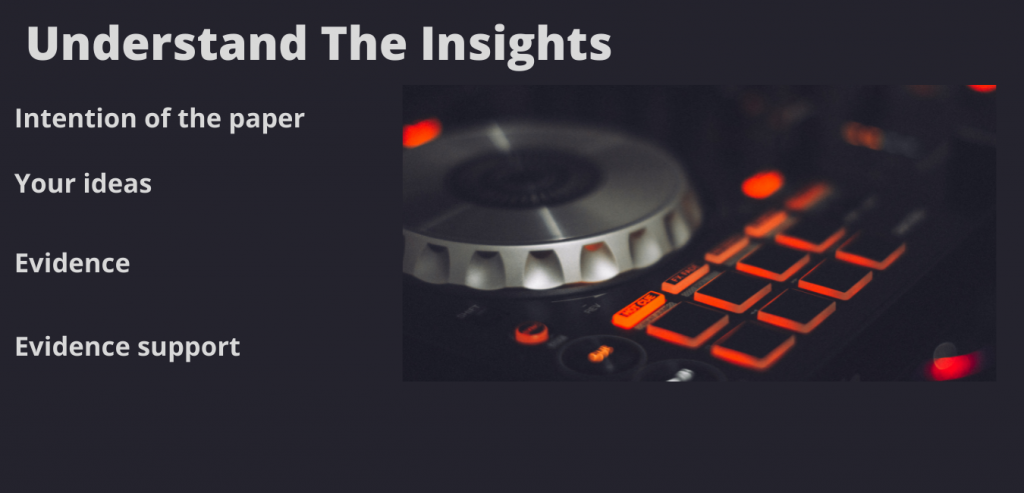
Reaction Paper Outline
The outline for a reaction paper should include the following pieces:
The introduction is the first paragraph of your reaction paper, and it should include three things:
- A thesis statement that provides your particular perspective on the assigned text.
- A brief explanation as to why this topic is important.
This paragraph needs to be written clearly and concisely .
Body paragraphs
The body is the largest part of your reaction paper. The body should be made up of at least three paragraphs that explain your reactions to the text. The most effective reaction papers are not only personal but also descriptive. While you do not need to retell the story in your reaction paper, you do need to provide enough detail about what occurred so that the reader can get a clear sense of what you are reacting to. Try to incorporate as many senses into your writing as possible; sight, sound, taste, touch, and smell.
The conclusion
The conclusion of your reaction paper should include one or two sentences that summarize the main ideas of your entire paper. In these concluding remarks, be sure to restate important points and refer back to the thesis statement. You can also use this opportunity to let your readers know what they will find interesting about this topic.
This paragraph needs to be written clearly and concisely.

Developing Your Reaction Paper
Writing a reaction paper is similar to writing an essay but requires that the writer include more evidence and perspective to support their argument. This means that there needs to be a clear thesis statement present in the paper and specific examples throughout the text that can help the reader understand what point of view you have. This also means that it is important to go beyond just stating what you think.
With a subject reaction paper, introduce the main idea with an introductory sentence that outlines what this particular perspective is all about and why it’s important to discuss (e.g., In this paper, I will be arguing that ____). The thesis statement should encapsulate the entire reaction paper in one or two sentences. The thesis statement should be specific and direct in its focus (e.g., not, this paper will argue that ____; instead, I believe that ____).
Your introduction should also include a brief explanation as to why this topic is important and how it relates to or impacts other perspectives we’ve studied (e.g., this story made me think of ____; this story reminded me of ____).
The body of your reaction paper should be divided into at least three paragraphs, with each paragraph focused on a particular claim you want to make. These are the main points that support your thesis statement.
Tips for Writing an Outstanding Reaction Paper
- Don’t be afraid to go into depth about your topic, and don’t just stick to the surface details. Be descriptive.
- Personal opinions are necessary for response papers, but you will need to include outside evidence to support those opinions.
- Writing reaction papers is similar to writing essays but requires that the writer include more evidence and perspective to support their argument.
- Ensure that your writing includes specific examples throughout the text, as this will help the reader understand what point of view you have.
- Have someone else read your response paper and provide feedback. Make sure to incorporate their suggestions if relevant when writing the final draft.
- If writing a reader reaction paper, remember that you are writing for someone who has NOT read the text in question. Therefore, it is important not to include any spoilers or details that could be potentially harmful to the experience of reading this text.
- Be aware of writing biases that could influence your writing. For example, don’t use words or phrases such as ‘I have to admit (e.g., I actually thought this was a good idea at first, but now I have to admit that it’s not). This is a biased way of writing what you think without really writing what you think.
- If writing a reader reaction, it is important to keep writing style and word choice simple so that the intended audience (e.g., High school students) can fully understand your writing without getting confused or lost in too many details.
- Remember that writing is constantly evolving, so try not to be afraid of adding new content or writing styles into your writing repertoire; this will only improve your writing skills in the long run.
Reaction Paper Example:
“The U.S. Presidential Election of November 9, 2016” and “A Tale of Two Cities: America Before and After the November 8th Election” are two articles that were published within a week of each other in newspapers across America on December 1, 2016.
In this paper, I will argue that the two articles are very similar in their perspective on the U.S. Presidential Election of 2016. They both share significant knowledge about the election’s impact on America as a nation.
This topic is important because this election has been going on for quite some time now, and it is important to have a proper perspective and understanding of what happened so that we can learn from it and move forward as a nation.
The world has been watching in anticipation on November 9, 2016, when the winner of this year’s U.S. Presidential Election was going to be announced. In “A Tale of Two Cities: America Before and After the November 8th election”, Ferdman talks about how the election has significantly impacted America’s economy and how Americans’ opinions about either candidate have created a divided nation. For example, Ferdman writes that “the economic forecast for the next four years is best described as cloudy” (Ferdman).
The author also mentions President-Elect Donald Trump’s plan to create jobs in America through a $1 trillion infrastructure investment plan. Ferdman describes the election as “a disconnect between the candidates and reality” (Ferdman). We can conclude from this that Ferdman is taking an opposing stance on Trump’s proposal because he views it negatively and does not think it is likely that it will be successful.
The article “The U.S. Presidential Election of November 9, 2016” by Elmlinger is another example of how negatively this election has affected America’s economy. Elmliger discusses the fact that Americans were already extremely divided before the election took place; for example, 52% of Donald Trump’s supporters would have been upset if he lost the election, and 45% of Hillary Clinton’s supporters would have been bitter if she lost (Elmliger).
Elmlinger also writes about how the election impacted businesses and the stock market, “American companies that rely on foreign investments have seen their stocks drop in value” (Elmlinger). This is evidence for Ferdman’s claim in his article that the election’s economic impact has been negative.
In conclusion, both articles make the same claim about how the U.S. Presidential Election of November 9 has negatively impacted America as a nation, and they do so using similar language and writing styles. For example, both authors use strong words like “disconnect”, “economic forecast”, “divided”, “cloudy,” and “negative” to describe their argument.
The language used to describe this event is very straightforward, which allows the intended audience (high school students) to fully understand the authors’ perspective on the election without getting confused by too many details.
Therefore, this topic is important because both authors have the same perspective on the election, making it easier to understand and analyze.
Common Mistakes to Avoid while Writing a Reaction Paper
Students often make lots of mistakes while writing a reaction paper. Here are some things to avoid while writing one:
- Don’t use this paper as an opportunity to make yourself look good by providing a completely different perspective than what is in the articles (in other words, don’t contradict yourself).
- Don’t include irrelevant information. The paper should be about the articles and related ideas only.
- While you can certainly use quotes from the articles, don’t quote every sentence or phrase that supports your perspective; instead, provide a good summary of what both authors believe.
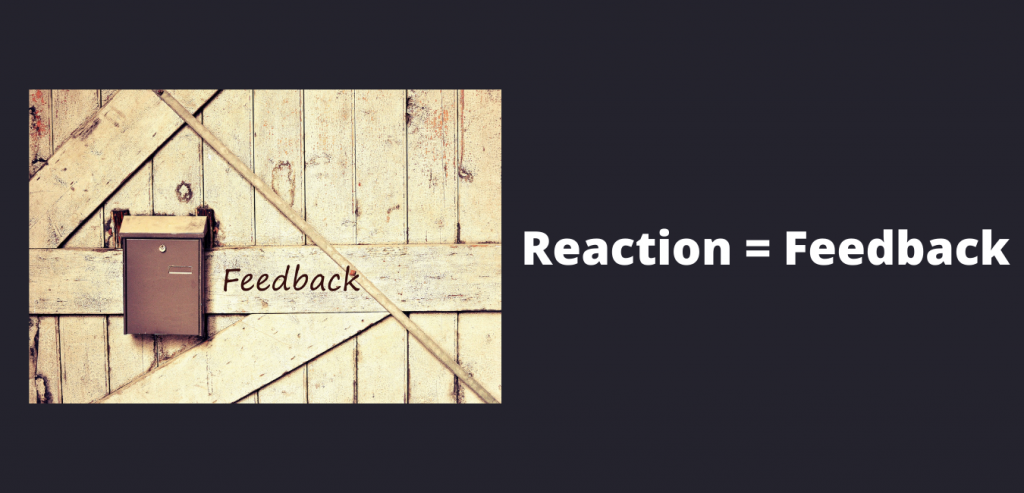
The reaction paper should be a personal opinion. It is important first to determine your angle and tone, then read the text carefully and deliberately. Understanding what you are reacting to will help understand how it may affect other people who are not in agreement with your viewpoint or argumentative stance. Finally, remember that this is just one person’s perspective on an issue; there is no wrong or right answer – only different perspectives for consideration.

I ‘m a freelance content and SEO writer with a passion for finding the perfect combination of words to capture attention and express a message . I create catchy, SEO-friendly content for websites, blogs, articles, and social media. My experience spans many industries, including health and wellness, technology, education, business, and lifestyle. My clients appreciate my ability to craft compelling stories that engage their target audience, but also help to improve their website’s search engine rankings. I’m also an avid learner and stay up to date on the latest SEO trends. I enjoy exploring new places and reading up on the latest marketing and SEO strategies in my free time.
Similar Posts

Top 10 Examples of Title Pages for Lab Report
A lab report is a form of technical writing used to present data and describe experimental or observational work. When writing lab reports, authors must include an overview of the experiment or observation and how it was done. A good lab report includes the title page, sometimes referred to as the cover page. It sets…

How to Operationalize Variables
This post will walk you through the process of operationalizing variables. Operationalization is a technique for making the theory more concrete and useful in research or application by naming, defining, measuring, and/or creating a procedure for executing them. How Do You Define Variables? Variables are the concepts, ideas, or characteristics that you want to measure…

How to Cite an Interview
Just like any other formal document, an interview needs to be cited correctly. Like other forms of writing, interviews follow the author-date method for citation. An interview citation is essential if the interview is used as a source of information in academic writing. Types of Interviews There are two main types of interviews in research….
How to Write a Philosophy Paper
Philosophical writing is very different from both creative writing and scientific writing. It’s not like fiction, where you can make up characters, plot twists, and dialogue. It’s also not like science, where you can make up hypotheses and then test them. Philosophical writing is more like history with the caveat that your “characters” are real…
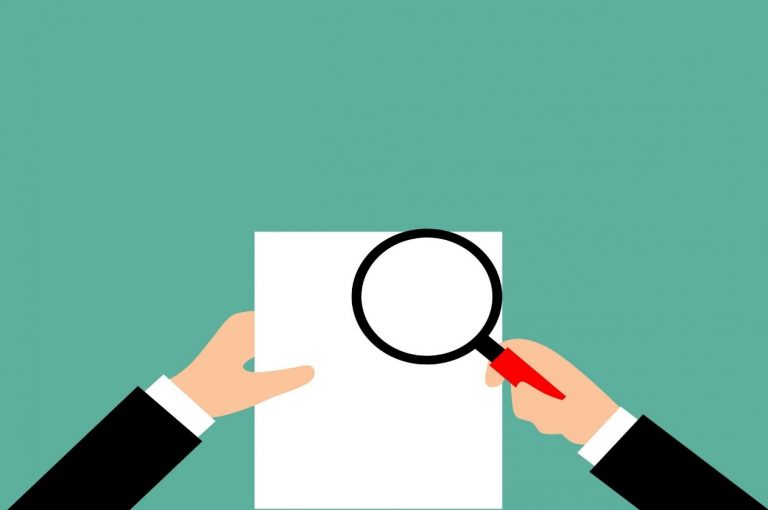
Background Information-Definition, Guide, and Examples
Background information is any info that informs the decision-making process but isn’t necessarily needed for it to be made. In research, background information is provided to help users. Decision-makers or researchers use this information to understand the context of a situation and how it came about. For example, when writing a paper, the author may…
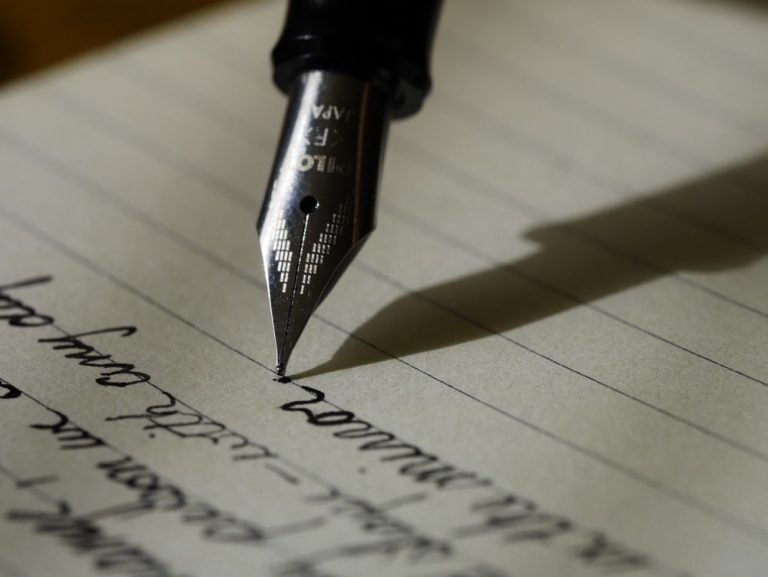
How to Write a Critique
This post provides steps on how to write a good critique, what makes up a compelling critique, and tips for writing successful critiques. Critiquing is not about you—it’s about the audience. What is the Definition of Critique Paper? A critique paper is a written evaluation of an academic work that provides positive and negative feedback…

Also Trending:
Reaction images images.
Browsing all 29,654 images
+ Add an Image
Sorted by: Newest Oldest Comments Favorites High Score Low Score Views

Legal Information: Know Your Meme ® is a trademark of Literally Media Ltd. By using this site, you are agreeing by the site's terms of use and privacy policy and DMCA policy . © 2007-2024 Literally Media Ltd.
Word Up! You must login or signup first!
Write an Outstanding Reaction Paper in APA Style

Introduction
Welcome to The Knowledge Nest, your ultimate resource for learning how to write an outstanding reaction paper in APA style. In this comprehensive guide, we will provide you with valuable insights, tips, and step-by-step instructions to help you create a high-quality and well-structured reaction paper that will impress your readers.
Understanding APA Style
Before we delve into the specifics of writing a reaction paper, it's important to have a clear understanding of the APA (American Psychological Association) style. APA style is widely used in the social sciences and is known for its specific guidelines on formatting, citing sources, and organizing written works.
Key Elements of a Reaction Paper
A reaction paper is a critical response to a particular text, article, book, or any other piece of literature. When writing a reaction paper, there are several key elements that you need to keep in mind:
- Summary: Start your reaction paper with a brief summary of the text you are reacting to. Provide enough information to give your readers a clear idea of what the text is about.
- Analysis: After summarizing the text, delve into a detailed analysis of its content. Discuss the author's main ideas, arguments, and evidence. Offer your own insights and interpretations, supported by solid evidence.
- Impact: Reflect on the impact the text has had on you personally and intellectually. Did it change your perspective? Did it resonate with your own experiences? Discuss how the text has affected you and why.
- Critical Evaluation: Provide a critical evaluation of the strengths and weaknesses of the text. Identify any logical fallacies, biases, or gaps in the author's argumentation.
- Connection to Course Material: If you are writing a reaction paper for a specific course, make sure to connect the text to the themes, concepts, or theories discussed in the course. Show the relevance of the text to the course material.
- APA Formatting: Ensure that your reaction paper adheres to APA formatting guidelines in terms of font, margins, spacing, and citation style.
Step-by-Step Guide for Writing a Reaction Paper
Step 1: read and understand the text.
Before you can write an effective reaction paper, it is crucial to read and thoroughly understand the text you are reacting to. Take notes, highlight important points, and make sure you have a solid grasp of the author's main arguments and ideas.
Step 2: Write a Summary of the Text
Begin your reaction paper with a concise summary of the text. Summarize the main points, key arguments, and supporting evidence presented by the author. Be objective and provide enough information to give your readers a clear understanding of the text's content.
Step 3: Analyze the Content and Organize Your Thoughts
After summarizing the text, delve into a detailed analysis of its content. Identify the author's main ideas, arguments, and evidence. Evaluate the effectiveness of the author's arguments and discuss any counterarguments. Organize your thoughts and supporting evidence to create a well-structured reaction paper.
Step 4: Include Personal Reflections and Reactions
A reaction paper is not merely a summary or analysis; it also requires your personal reflections and reactions to the text. Discuss how the text impacted you personally and intellectually. Did it challenge your beliefs? Did it inspire you? Share your genuine thoughts and emotions.
Step 5: Evaluate the Strengths and Weaknesses
In this step, critically evaluate the strengths and weaknesses of the text. Identify any logical fallacies, biases, or gaps in the author's arguments. Provide examples and evidence to support your evaluation. Remember to be fair and balanced in your critique.
Step 6: Connect the Text to Course Material
If you are writing a reaction paper for a specific course, make connections between the text and the course material. Discuss how the text relates to the themes, concepts, or theories covered in the course. Demonstrate your understanding of the course material and its application to real-world examples.
Step 7: Revise and Proofread Your Paper
Once you have completed your reaction paper, take the time to revise and proofread it. Check for any grammar or spelling errors. Ensure that your paper flows well and that your arguments are coherent and supported by evidence. Make any necessary improvements to enhance the overall quality of your paper.
Congratulations! You now have all the necessary tools and guidance to write an outstanding reaction paper in APA style. Remember to follow the guidelines we've provided, organize your thoughts, and express your ideas clearly and concisely. By incorporating your personal reflections, thoughtful analysis, and adherence to APA formatting, you will create a reaction paper that stands out. Embrace the opportunity to showcase your critical thinking skills and contribute to the academic and intellectual discourse within your field of study.
About The Knowledge Nest
The Knowledge Nest is a leading online platform dedicated to fostering knowledge and learning in various fields. As a hub for comprehensive educational resources, we aim to empower individuals to enhance their skills and excel in their academic and professional endeavors. Our team of experts is committed to providing valuable insights, guides, and tips to help our community thrive. Join The Knowledge Nest today and unlock your true potential!

Family Bonding Essay Examples & Topics

Pay for Coursework - Studybay

The Importance of Practical Work in Science Education

Advantages and Disadvantages of Colonialism - Studybay
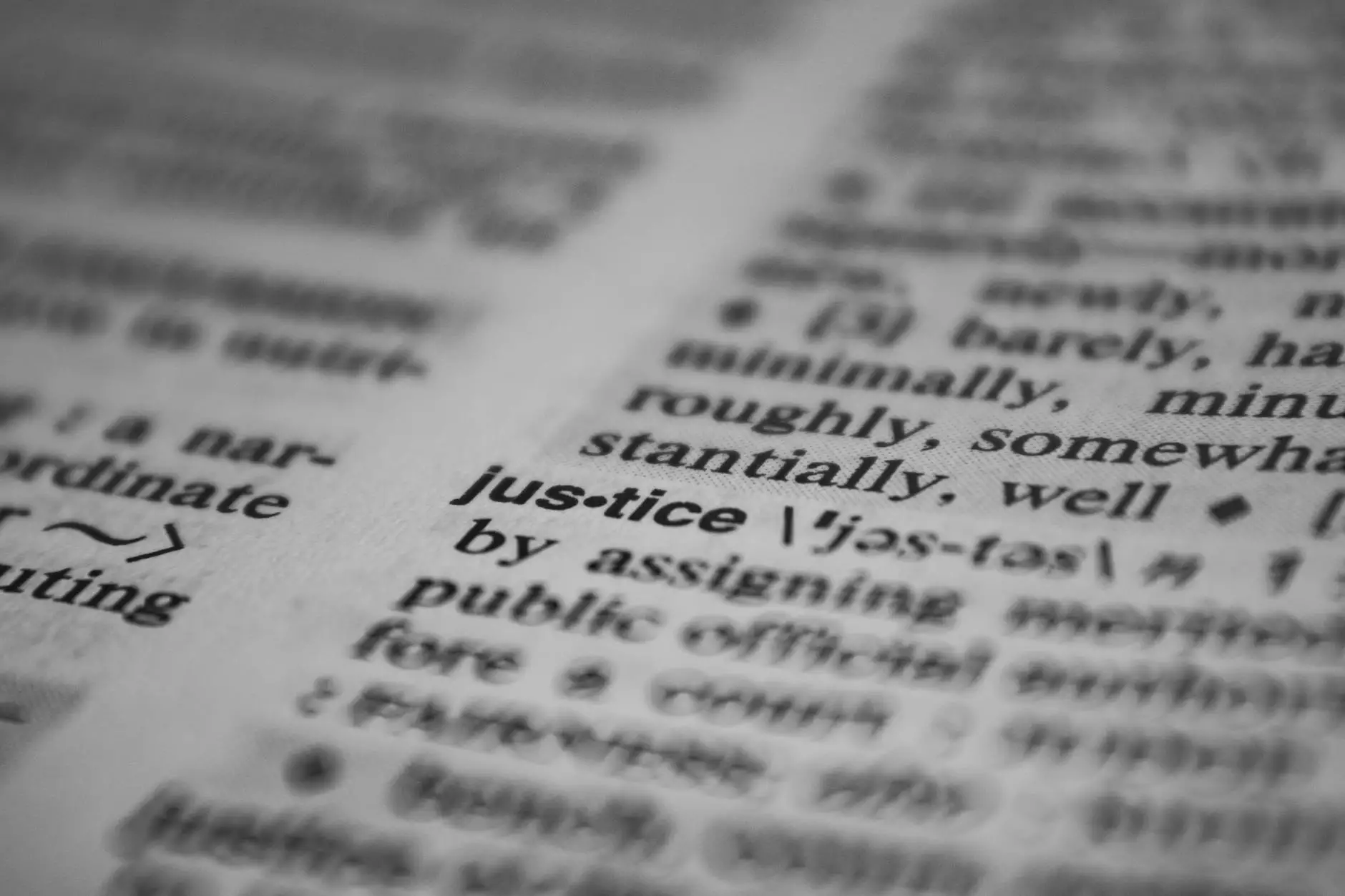
What Is a Mixture: Types, Examples, Definition

Engineering Coursework Writing Service - Studybay

Dealing with Zero and Negative Exponents: the Complete Guide

The Philippines Is a Developing Country Essay

How to Write a Law Review Article?

Maslow and Rogers Similarities and Differences

IMAGES
VIDEO
COMMENTS
Take notes along the way and try to see things from different angles. When it comes to writing your paper, aim for a thoughtful response, not just a knee-jerk reaction. Back up your points with solid evidence and organize them well. Think of it more like writing a review than leaving a quick comment on a movie website.
First, you need to introduce the subject of your paper. Name the author and the type of work you're responding to; clarify whether it's a film, a text, or a work of art. Next, you need to voice your opinion and evaluate the assigned subject. You can use phrases like, "I think…. In my opinion…. My first reaction was….
The Origin. Reaction images have their roots in the pictorial representation of facial expressions known as emoticons, with the first recorded instance produced by Scott Fahlman on September 19th, 1982.The exact origin of reaction images is difficult to trace, but its early examples have appeared on Futaba Channel and 4chan.What Are Reaction Images?
1. Write your introduction. Make sure your introductory paragraph states the name of the text, the author, and the focus of your paper. You may also want to include the year of publication and the publication it was taken from if relevant. It is also good to include the topic of the text and the author's purpose.
Get ready to laugh out loud with these hilarious reaction paper memes. Discover the funniest and most relatable memes that perfectly capture the essence of writing a reaction paper. Share the laughter with your friends and enjoy a good chuckle together.
A reaction paper follows a typical five-paragraph essay format with an introduction, body paragraphs, and a conclusion. The next section will go in-depth into how to write a reaction paper section by section. In general, the first introductory paragraph should contain a brief summary of the source material. The body paragraphs should start with ...
It's a free online image maker that lets you add custom resizable text, images, and much more to templates. People often use the generator to customize established memes , such as those found in Imgflip's collection of Meme Templates . However, you can also upload your own templates or start from scratch with empty templates.
The reaction meme GIF offers a wordless way to express a vast range of emotions, enhancing our digital interactions and making them more relatable and engaging. The reaction memes holds a special ...
How do you write a reaction paper? Is it the same with writing a reflection paper? Let's #LearnWithLyqa!💡 CONNECT WITH @Team Lyqa 💡Main channel: Team LyqaT...
Speaking of films, below you will find an example of a movie reaction paper. For additional guidance, feel free to explore our article on discursive essay format. Remember, writing a reaction paper is an opportunity to express your unique perspective and insights, so embrace the process with enthusiasm and a critical eye.
Madalas bang requirement sa school niyo ang reaction paper, pero hindi ka pa masyadong marunong o medyo nagtatagal ka sa paggawa? Watch this video, and for s...
In a reaction paper conclusion, the author usually restates the thesis statement supporting it with some new ideas mentioned in the main body. If this seems too complicated, don't worry; check the sample reaction essay below! 🔖 Reaction Paper: Example. The essay below is an excellent example of a neat reaction paper structure.
Let's consider a short reaction paper example: J.K. Rowling has written a perfect piece for children of all ages, taking a particular focus on adolescents. The franchise is ranked # 1 on the most profitable film series with $ 7.7 billion in worldwide profit. "Harry Potter" is a living confirmation of the idea that the success of a film does not ...
Write the Header Bodies. You can now go through each header, stating your thoughts about each section. Try not to repeat yourself through these areas, as it could harm the readability of the piece; it could confuse readers and break the flow of the paper. This section is the meat of what you are writing.
reaction Meme Templates. Search. NSFW GIFs Only. Mr. McMahon reaction. Add Caption. Vince McMahon Reaction w/Glowing Eyes. Add Caption. Live reaction. Add Caption. Surprised Joey. ... Search the Imgflip meme database for popular memes and blank meme templates. Create. Make a Meme Make a GIF Make a Chart Make a Demotivational Login . Login ...
3. Create the paper's outline. Again using your notes, start building the framework for your arguments. Fleshing out these ideas while writing your reaction will be much easier and more organized when you're following an outline. 4. Compose the first draft. Use your outline to form the first draft of your work.
Our paper writing service has helped hundreds of students with their reaction papers, and they can write your paper for you too! Just follow the simple steps below! Click the "Order Now" button below. Fill in the paper requirements and other required fields. Make and confirm payment.
Clip Has Inspired Jumpscare Memes Since 2017 'Llegué De La Barbería': Wholesome Trend On TikTok Shows Dogs Getting Haircuts In A Barbershop Whatever Build You Do In 'Skyrim', Degrading Into Sneak Archer Is Inevitable, Or So The Memes Have It
APA Formatting: Ensure that your reaction paper adheres to APA formatting guidelines in terms of font, margins, spacing, and citation style. Step-by-Step Guide for Writing a Reaction Paper Step 1: Read and Understand the Text. Before you can write an effective reaction paper, it is crucial to read and thoroughly understand the text you are ...
153M views. Discover videos related to Reaction Meme on TikTok. See more videos about Shocked Reaction Meme, Honest Reaction Meme, Ariel Black Reaction Meme, Meme Reaction Videos, Memes for Reaction, Happy Reaction Meme. Replying to @ph0nk1xcrz I'll make one for each part but here's part 1 for now #reactionpics #meme #cropped #crop # ...
How to do a reaction paper literally. Credits to the original uploader. All reactions: 18
The paper concludes with the cultural significance of employing memes in qualitative work as innovative approaches in data collection and research representation. ... particularly through their discussion of the meme and their reaction. In this way memes can do more than just be a way to express thoughts, but a mechanism for the researcher and ...